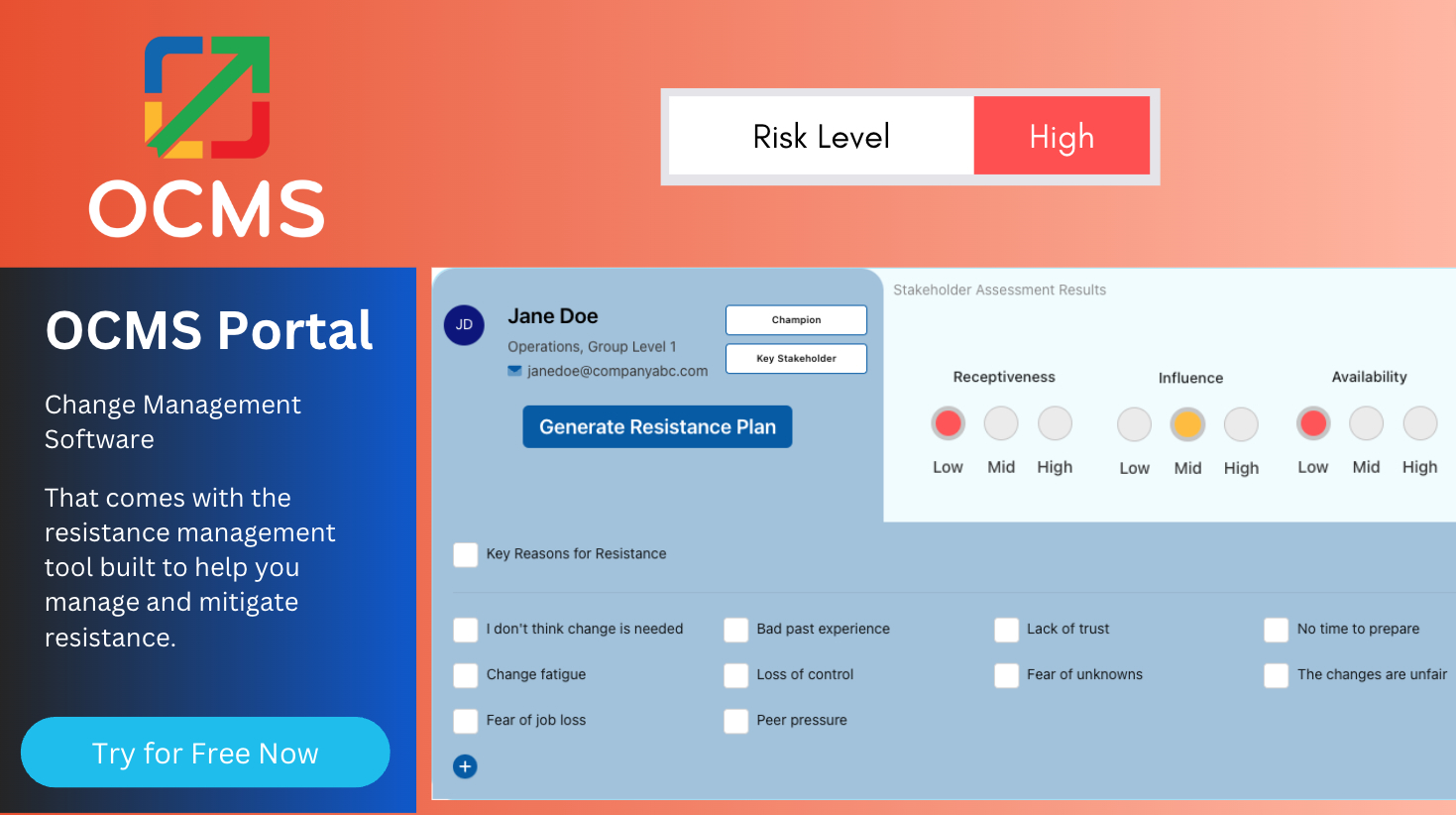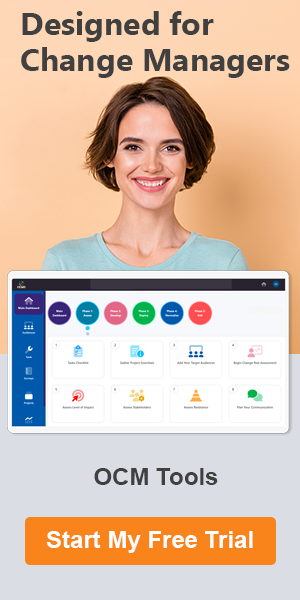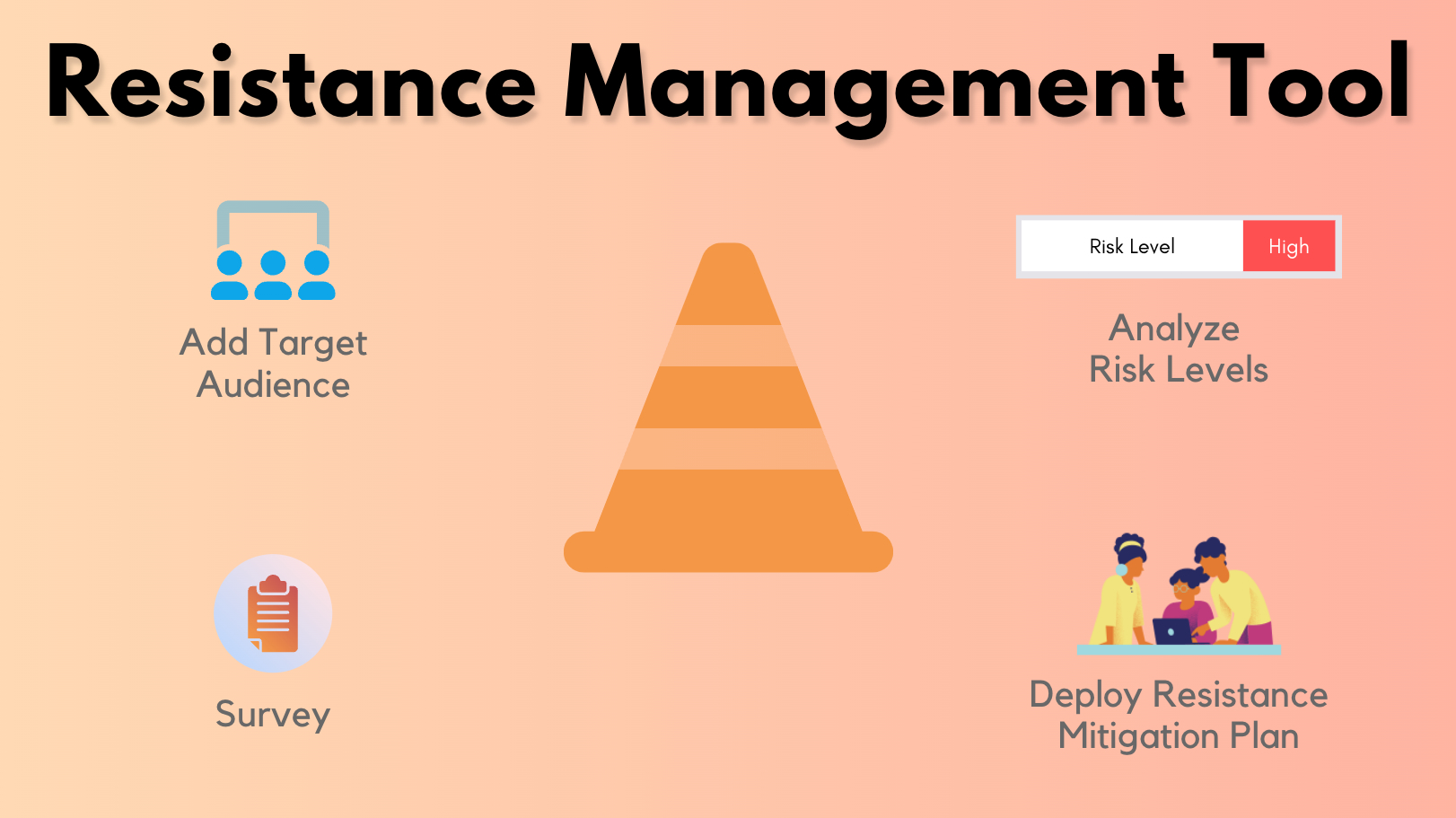A Simple (But Detailed) Guide for Managing Resistance to Change in Organizations
 Unlocking Success: Your Guide to Managing Resistance to Change
Unlocking Success: Your Guide to Managing Resistance to Change
As we navigate through the dynamic landscape of modern organizations, embracing change is often necessary for growth, innovation, and progress. However, change can be met with resistance, and managing this resistance is a skill that can truly unlock the door to success.
Welcome to your guide on how to effectively manage resistance to change. We’re here to take you on a journey of discovery, providing you with the tools, strategies, and insights to navigate the sometimes choppy waters of transformation.
Change doesn’t have to be daunting or met with hesitation. In fact, it can be an opportunity for improvement, evolution, and positive growth.
The key is understanding how to handle resistance in a way that fosters collaboration, communication, and ultimately, successful change.
Throughout this guide, we’ll explore the diverse types of resistance you might encounter, whether within your team, your organization, or even from customers. We’ll share valuable techniques for addressing resistance, and we’ll emphasize the importance of proactive and reactive approaches. After all, mastering the art of change management isn’t about eliminating resistance; it’s about working with it to create a stronger, more resilient future.
So, let’s embark on this journey together, embracing change as a gateway to new opportunities. Get ready to learn, adapt, and become a master of managing resistance to change. Your success story is begins today.
Interested in a quick summary to kick things off? Perfect, we’ve got that lined up for you. If you’re eager to dive into the nitty-gritty of the most effective resistance management techniques, hang tight because we’re here to guide you every step of the way!
Quick Summary
Distinguishing Between Resistance and Stakeholder Management
Resistance management and stakeholder management are interconnected but distinct concepts in the context of change planning strategies.
Stakeholder Management involves identifying and managing all key stakeholders, including individuals, sponsors, executives, customers, vendors, and other groups affected by a project. The aim is to gather information about their roles, attitudes, and potential impacts on the project, allowing for a strategic approach in engaging with them.
Resistance Management, on the other hand, focuses specifically on stakeholders who exhibit resistance to organizational change. It entails creating and implementing strategies to reduce their resistance, ensuring the project’s success. While stakeholder management covers all key stakeholders, resistance management addresses the subset of stakeholders who are opposed to the project.
In summary, stakeholder management is a comprehensive approach to engage with all key stakeholders, while resistance management is a targeted effort to address and mitigate resistance within the stakeholder group opposing the change.
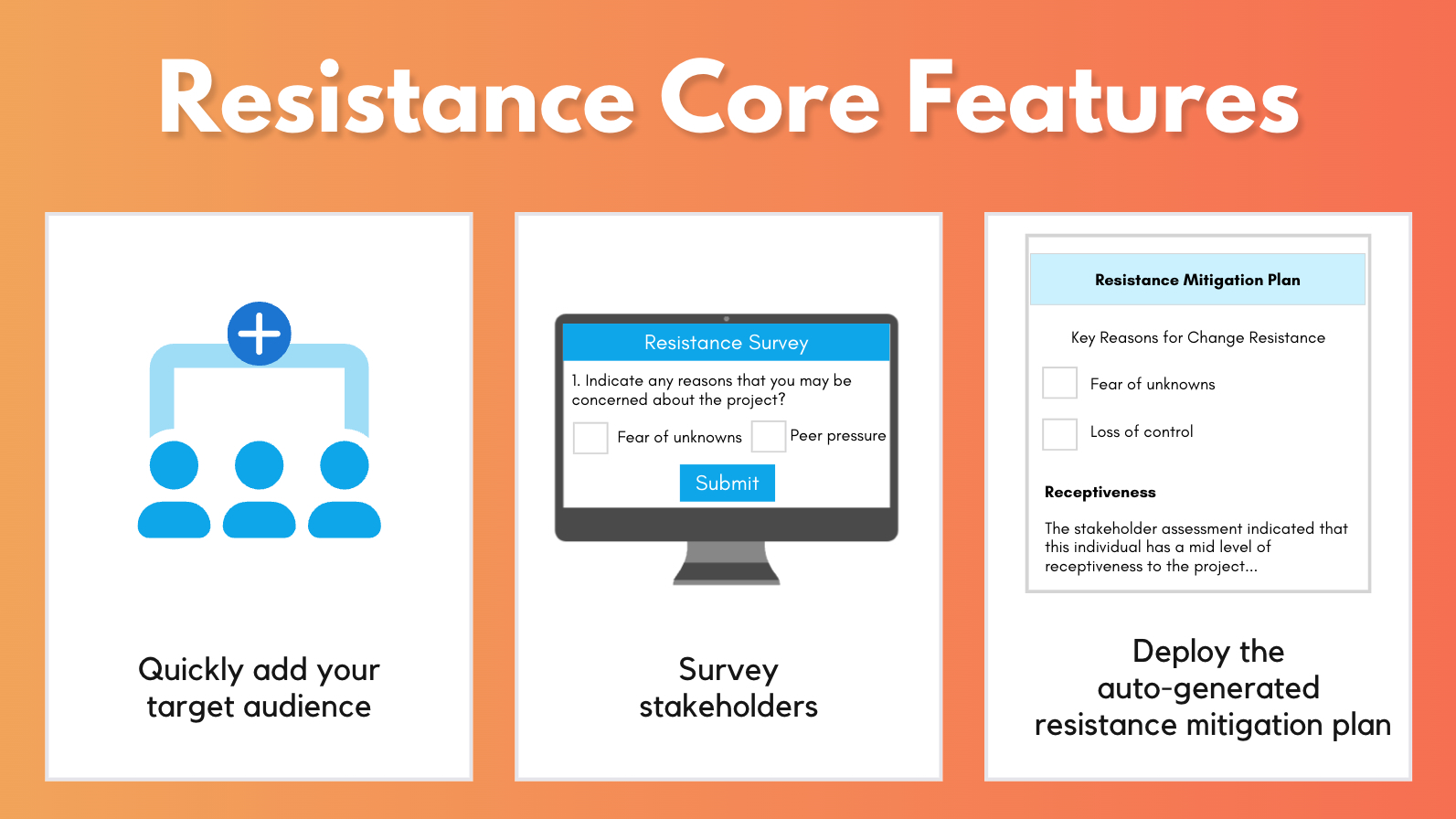
Struggling with complicated resistance management software? Well, now is the ideal time to discover the OCMS Portal. Our All-in-One OCM solution includes the user-friendly Resistance Management Tool, designed to simplify the evaluation of change-resistant individuals. Sign up with us today for free, and no credit card is required.
Challenges of Change: Why People and Stakeholders Resist
Resistance to change is a common response in organizations, primarily rooted in the fact that people generally dislike change. This resistance is a normal human behavior driven by several factors:
- Disruption of Routine: Change disrupts established habits and automatic routines, leading to resistance because it represents a loss of familiarity.
- Human Nature: People naturally resist change, even if it offers improvements, due to their inherent comfort with the status quo.
- Learning Curve: Resistance can stem from the perceived effort and time required to learn new ways of doing things.
- Fear of Negative Impact: Individuals may fear that the change will have adverse consequences for them personally or professionally.
- Change Fatigue: A high frequency of ongoing changes can lead to resistance, as people may feel overwhelmed by constant adjustments.
In essence, resistance to change is a typical response driven by the desire for stability and comfort in familiar routines. Understanding these factors is essential for effectively addressing and managing resistance within an organization.
Exploring the Why Behind Change Resistance
Resistance to change within organizations can have various sources and causes. Understanding these factors is crucial for addressing and managing resistance effectively. Some key sources and causes of resistance to change include:
- Inertia and Familiarity: People resist change when they are comfortable with their current way of working and are averse to learning new methods.
- Ownership and Efforts: Users who have contributed to the existing processes may be resistant to changes that disrupt their efforts.
- Preference Discrepancy: Those who advocated for one option but saw another chosen may exhibit resistance.
- Lack of Awareness: When individuals do not understand the reasons for change, including the business drivers, they may resist it.
- Increased Workload: The expectation of additional work due to the change can lead to resistance.
- Job Security Concerns: Fear of job loss or uncertainty about the impact on job security can trigger resistance.
- Leadership Support: A lack of support or visibility from senior leaders and managers can contribute to resistance.
- Negative History: Past experiences with unsuccessful changes can foster resistance to new initiatives.
- Perceived Transience: When employees view the change as short-lived, they may resist it, based on prior experiences.
- Overwhelm: Employees already feeling overloaded may resist additional change due to a lack of bandwidth.
- Peer Pressure: Colleagues opposing the change may influence others to resist it, even if they personally don’t object.
- Customer Impact: Customers facing substantial changes or higher costs may resist changes to organizational processes.
- Vendor Concerns: Vendors may resist changes that increase their workload or costs.
- Management Fatigue: Managers and executives feeling overwhelmed by constant changes within the company may resist new initiatives.
Developing proactive strategies to manage resistance is key to successful change initiatives in the workplace.
These sources of resistance can be rooted in personal, group-related, logistical, or other factors. It’s essential to identify the specific causes to address them effectively.
Strategies for Proactive and Reactive Resistance Management
Proactive resistance management is a forward-thinking strategy that anticipates and addresses potential resistance to change before it becomes a problem. It involves assessing historical receptiveness to change, gathering relevant data, and addressing key questions. Implementation includes strategies like assessments, databases, engagement approaches, ongoing tracking, and reporting to ensure early identification and resolution of resistance.
Key points about proactive resistance management:
- Anticipatory Approach: Proactive resistance management is about foreseeing where resistance might emerge in the future and taking steps to minimize it in advance.
- Understanding Historical Receptiveness: It involves assessing the historical or existing willingness of different groups to accept change and identifying individuals within these groups known for resistance.
- Data Gathering: Collecting data that can influence an individual’s expected resistance or acceptance of a project.
Reactive resistance management addresses resistance to change as it arises, rather than proactively preventing it. Despite proactive efforts, unexpected resistance can occur. Identifying reactive resistance involves ongoing meetings, a Change Champion Network, surveys, and direct observation of resistance signs. Documenting identified resistance and resistors in a matrix allows for taking immediate actions to mitigate the issues. Reactive resistance management complements proactive strategies by addressing resistance as it surfaces.
Key points about reactive resistance management:
- Responsive Approach: Reactive resistance management entails reacting to identified resistance rather than proactively preventing it.
- Unforeseen Resistance: Despite proactive efforts, unexpected resistance may emerge from customers, vendors, managers, or employees.
- Causes of Reactive Resistance: Resistance can develop when changes disrupt day-to-day work or when influencers within the organization oppose the project.
The OCMS Portal change management All-in-One suite provides the most comprehensive resistance management software among other tools to help with change management success. Try all of this for free (no credit card needed).
Addressing Various Types of Resistance to Change
To effectively address and overcome resistance to change in the workplace or with customers, consider the following techniques:
- De-Personalize Resistance: Avoid taking resistance personally; it’s not about you but about the change itself.
- Early Detection: Start identifying resistance as soon as possible, rather than waiting until it becomes severe and challenging to mitigate.
- Frequent Communication: Communicate regularly and create opportunities for end-users to express their thoughts and feelings about the change.
- Employee Involvement: Involve employees in the implementation process, making them feel like partners in the change rather than passive recipients.
- Open Expression: Encourage employees to express their resistance without fear of punishment. Covert resistance can be harder to identify and address.
- Continuous Management: Recognize that managing resistance is an ongoing process, not a one-time event. Resistance may evolve with the implementation, so use both proactive and reactive techniques to assess, identify, and resolve resistance at different stages.
- Supervisory Involvement: In most cases, the direct supervisor or the highest-level manager in the chain of command should manage resistance. Collaboration with managers, project sponsors, subject matter experts (SMEs), Change Champions, and key stakeholders is crucial for implementing resistance management plans effectively.
These techniques help address and mitigate resistance throughout the change implementation process, fostering a smoother transition.
Detailed Deep Dive
Complete Guide to Overcoming Resistance to Change with Specific Individuals or Groups
This free resistance management guide provides you with a step-by-step overview and everything you need to know for identifying and managing resistance to change in an organization.
It provides answers to often asked questions, like “Why are people resistant to change?” and “what are six strategies for overcoming resistance to change in organizations?”
This guide is designed for Change Management Practitioners, Project Leads, Program Managers, Coaches, Group Leaders, Managers, HR Specialists, Project Management Managers, Firm Leaders, and other practitioners, and it outlines best practices and plans for managing resistance to change at your organization.
Included below, you’ll find the best resistance management practices, as well as links to a top OCMS Portal resistance management tool to managing resistance to change in an organization.
We’ve also referenced templates that you can use to minimize or eliminate resistance at the team, group, department, or regional levels.
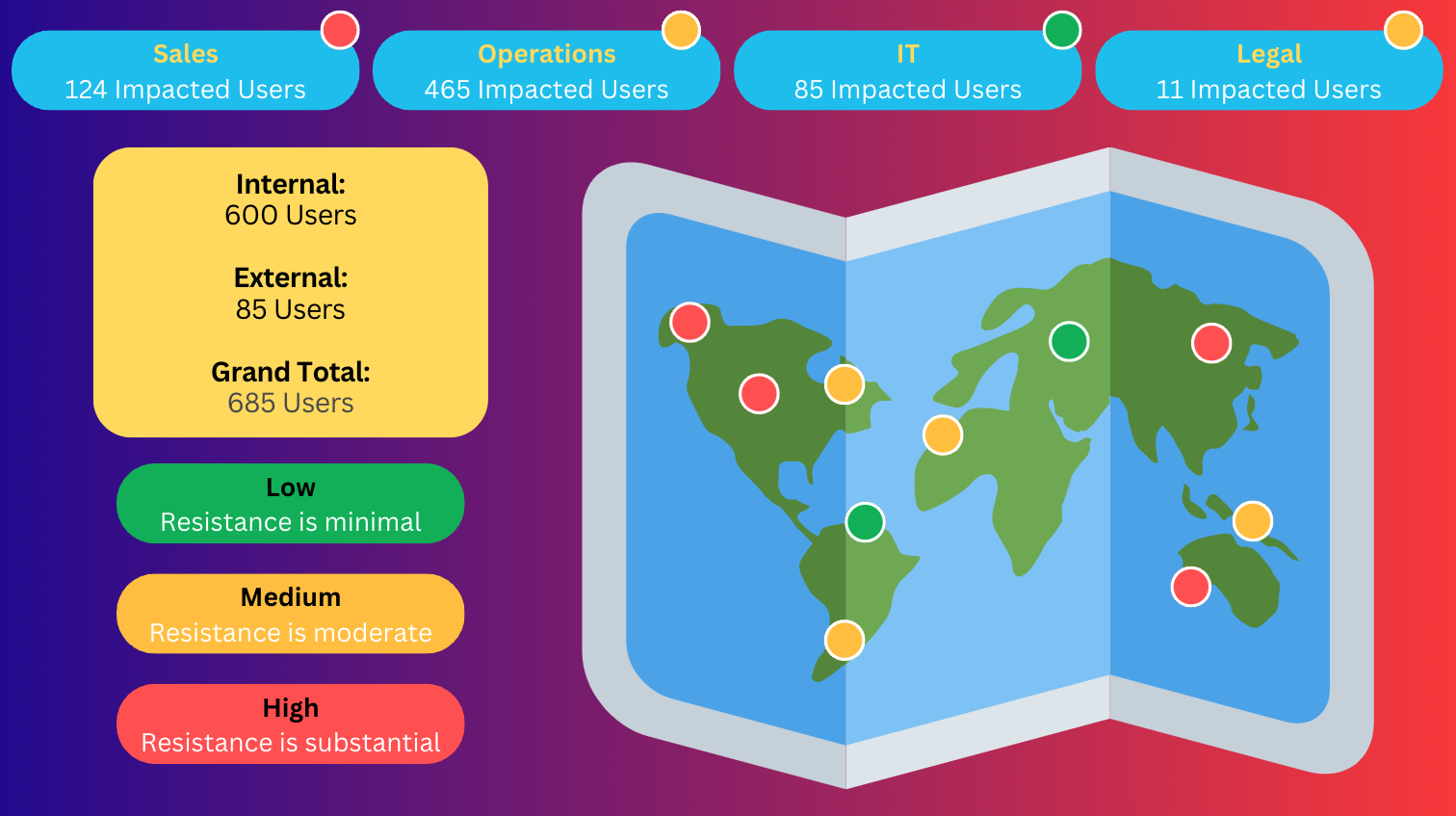
“I have been a Change Management Lead for over 15 years and have led large scale business transformations across Cisco, HSBC, Intel, Accenture, the U.S. Federal Reserve Bank, Deloitte, and other firms. Oftentimes I have had to implement plans to help organizations in overcoming resistance to change.
Throughout my tenure in driving change, I have discovered that applying the best practices described below have increased my successes in managing and resolving the various types of resistance to change.”
Ogbe Airiodion
Senior Change Management Lead
Table of Contents – Everything You Need to Know for Overcoming Organizational Resistance to Change
The sections below provide clarity on why people are resistant to change, as well as key insights into what resistance looks like, and how to manage it.
Click any of the links below to jump to a specific section or keep scrolling down.
1. How Does Resistance Management Differ from Stakeholder Management?
2. What is Resistance to Change Meaning?
3. What is a Resistance Management Plan?
4. Why Do People & Stakeholders Resist Change?
5. Sources and Causes of Resistance to Change
6. What Does Resistance Really Look Like?
7. Examples of Resistance to Change Quotes
8. Types of Workplace Resistance
9. How to Overcome Resistance to Change
10. Proactive Resistance Management
11. Reactive Resistance Management
12. How Do You Measure Resistance, Availability, Etc.?
13. Overcoming Resistance to Change Using a Reactive Strategy
14. Additional Techniques for Addressing Different Types of Resistance to Change in the Workplace or with Customers
15. The True Costs of Resistance to Project or Business Change
16. OCMS Portal: Resistance Management Tool
17. Getting Started with OCMS Portal Tools
Resistance is often subtle in nature, and we’ve provided best practices for identifying the various sources of resistance, as well as presenting key plans for mitigating the different levels of stakeholder resistance.
Do you have any questions about six strategies for overcoming resistance to change? Or like to provide more feedback on the often asked “why are employees resistant to change” question? Please reach out and let us know.
Toolkit for Managing Resistance to Change
Do you want a “managing resistance to change pdf, PPT, or Excel” template? You can use OCM Solution’s #1 Ranked Minimizing Resistance to Change Tool in the OCMS Portal platform to help.
Whether you are seeking a Prosci resistance management plan template, a John Kotter resistance to change tool, or other types of tools, our Resistance Management Toolkit is equally suited to newbies and experienced change managers alike.
Click below to preview this toolkit for dealing with resistance to change.
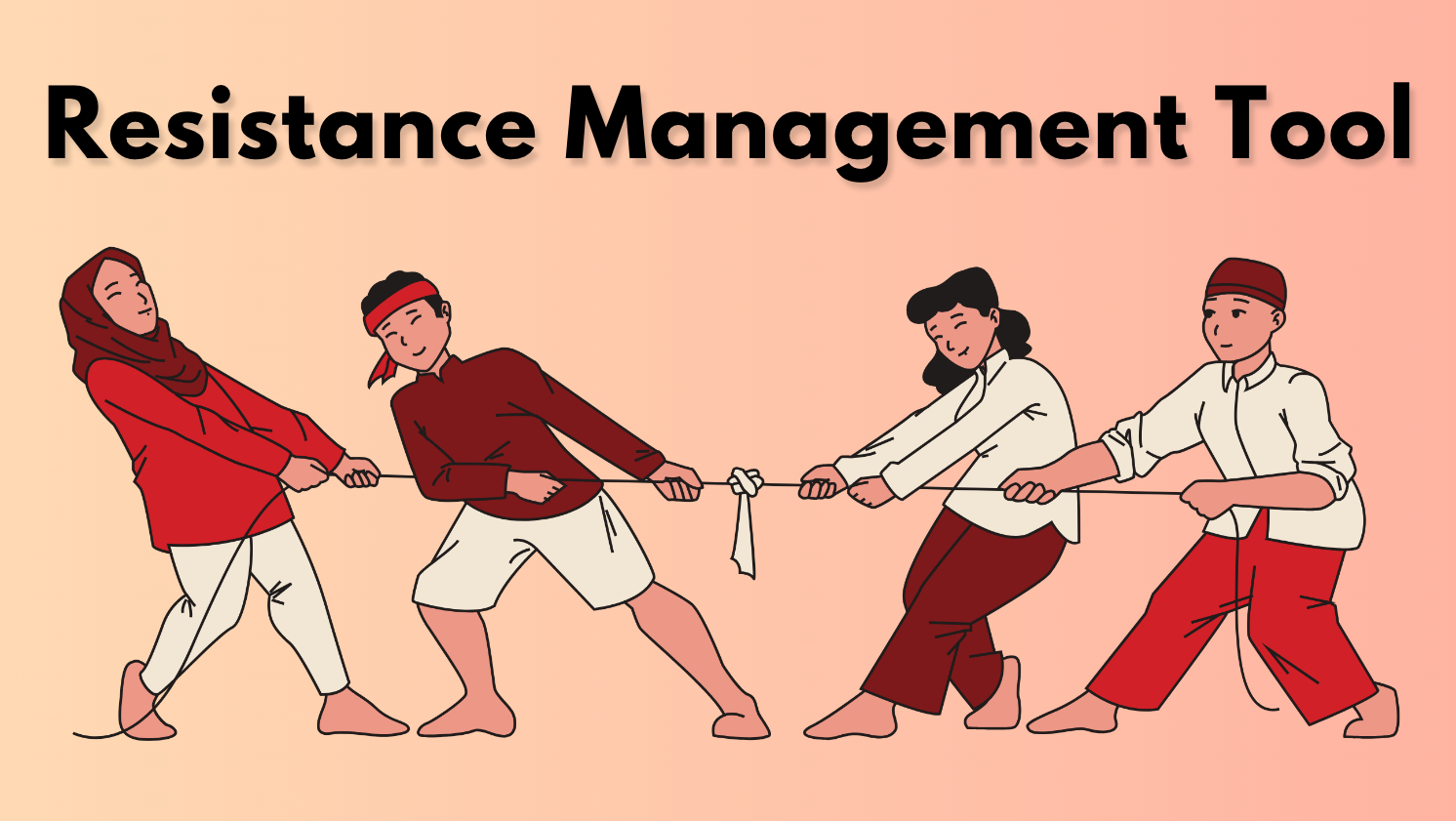
Toolkit for resistance to organizational change
Do you have any questions about this organizational resistance to change guide? or “Why are people resistant to change”? Please reach out and let us know.
How Does Resistance Management Differ from Stakeholder Management?
When putting together a change planning strategy or reviewing resistance to change models at the start of your project, you’ll undoubtedly see that both stakeholder management and resistance management are connected.
When you’re managing stakeholders, who are individuals, sponsors, executives, customers, vendors, and other representatives of groups being impacted by a project, you’ll need to identify several data points. This information will inform your engagement strategy with each stakeholder.
Part of the stakeholder management process is identifying individuals and groups showing resistance to change in the workplace.
This portion of your stakeholders that are resisting the change will need to be managed differently than stakeholders that are not opposing the project. So, while stakeholder management and resistance management are related, they are two separate functions. This is why it’s important to conduct a separate resistance management strategy.
In short…
- Stakeholder Management is to assess, track, and manage ALL key stakeholders for a change project. The goal is to identify stakeholders that are resistant, supportive, willing to help, can impact the project the most, etc. so you can take the logical next steps with them.
- Resistance Management is to assess, track, and manage only those stakeholders that are resistant to organizational change. The goal is to create and implement a strategy that will reduce that stakeholder’s resistance towards the change project to help ensure your project is as successful as possible.
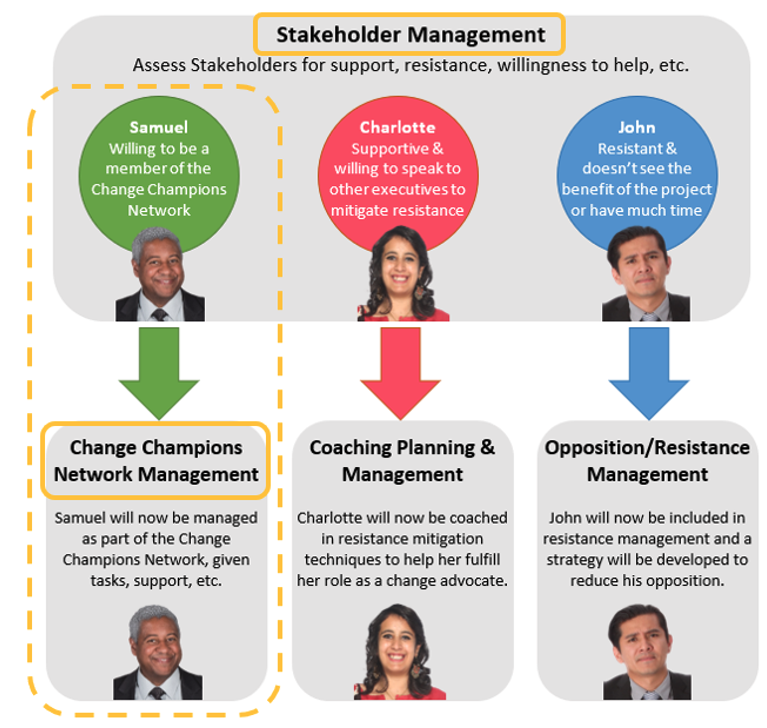
Example of how Stakeholder Management and Resistance Management are connected.
In Which Phase(s) of Your Project Do You Do Resistance Management?
If you are following a popular change management and resistance to change model, such as the OCM Solution Change Management Framework, you’ll find that different change activities are performed at different phases of a project.
For example, the OCM Solution Change Model has five phases:
- Phase 1: Assess
- Phase 2: Develop
- Phase 3: Deploy
- Phase 4: Normalize
- Phase 5: Exit
Resistance Management is done in Phases 1 to 4 because it’s a big part of keeping a change project on track both during project implementation and after the go-live date.
When you are conducting your various change assessments, you will naturally identify those stakeholders that are resistant during your Stakeholder Analysis (which is performed during Phase 1). So, you can begin to gather your initial data and begin proactive resistance management planning during Phase 2 when you are developing the planning for your change strategy.
The bulk of your resistance management activities will come during change plan deployment, which is Phase 3, as you are mitigating the risk for your project to help ensure success. This is when reactive resistance management will come into play.
Phase 4 is the normalize phase. This is when you’re cementing learned behaviors and ensuring that users don’t revert to the “old way” of doing things.
Resistance management is important here as well because you’ll inevitably have stakeholders that think the new process is too hard and it was easier to do things the old way. They may also run into stuck points and need additional training or guidance to help them optimize their adoption of the new process.
In the section below, let us cover the resistance management definition. What is resistance, and what does it really mean?
Tool for Managing Resistance to Change in the Workplace
What is Resistance to Change Meaning?
What is resistance to change definition? Resistance to a change is the situation whereby impacted audiences and individuals are not supportive of a transformation project, which results in them acting in ways that negatively impact the success of the change. These can be both overt and subtle shows of change resistance.
Resistance to change is not always internal. There are situations where a government or a business organization faces external resistance where customers, vendors, suppliers, and external parties are not in support of a change that the organization is implementing and are acting in ways that hinder the success of the change.
In addition to the resistance to change definition above, let us review planning to manage resistance in the section below.
Tool & Templates for Overcoming Organizational Change Resistance
What is a Resistance Management Plan?
A resistance management plan involves the set of steps, strategies, activities, and approaches used to identify, evaluate, manage, and resolve resistance to change.
Assessing and identifying resistance, and then applying proactive and reactive plans are proven strategies to overcoming resistance to change in an organization.
An effective plan allows you to successfully identify all the individuals and groups that are either resisting a change or who are not receptive to the change and allows you to effectively engage these groups and overcome their resistance to the change project that you are supporting.
You can think of resistance as an opposing force to the transformation project that you’re trying to drive. Your positive actions, such as communications, training, and direct engagement are positive forces that move the project forward.
It’s important to have an organized strategy for reducing that resistance to eliminate, or greatly mitigate, opposition so your project can be successful.
Seeking a Kotter and Schlesinger resistance to change template? Check out the OCMS Portal Tool for Managing Resistance to Change in the Workplace
Why Do People & Stakeholders Resist Change?
Resisting change in an organization is a common behavior. People generally do not like change, and so the first thing you should understand is that resistance to a change is normal human behavior.
Change involves uprooting habits and behaviors that have become second nature and that are often done automatically as part of a routine. Overcoming employee resistance to change involves understanding that it means a loss of that routine and why it’s human nature to resist change.
Even if the change presents a wonderful improvement to existing issues, there will still be some levels of resistance to the change.
Comfort with the status quo is extraordinarily powerful. Key reasons why people resist change include not wanting to spend time learning the new way of doing things, being fearful of a negative impact on them, and currently being burdened with too much change. See the sections below for more reasons on why people resist a change.
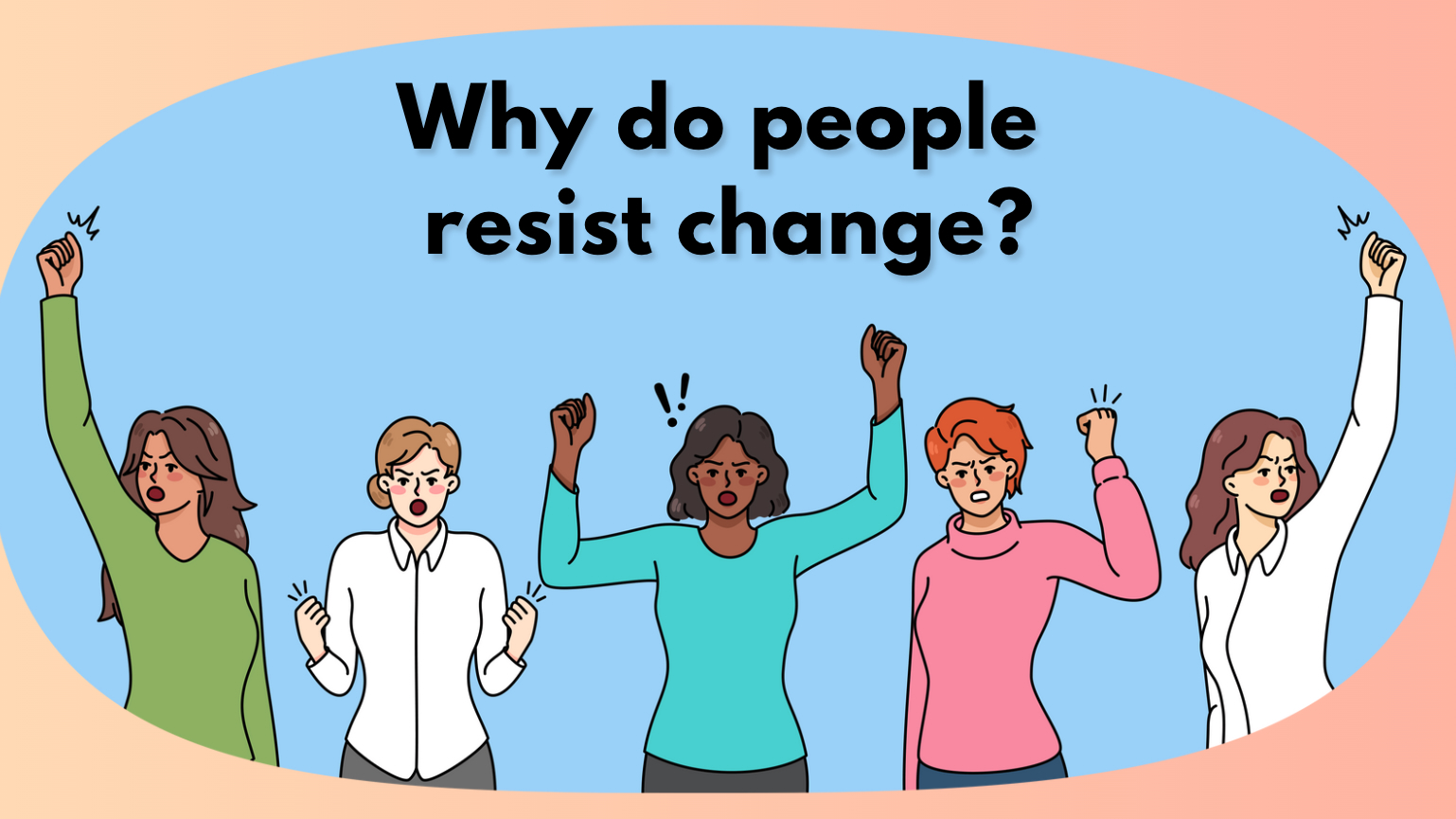
Resistors rarely show up looking like this lady. Sometimes they do, but most often, resistance is covert and subtle.
Below are examples of sources of why employees, customers, and managers resist change. Reach out to us if you have any examples and best practices about managing resistance to change at your organization.
Sources and Causes of Resistance to Change:
- A key cause of resistance to change is when users are heavily invested in the current way of doing their work and do not want to undergo the process of having to learn new ways of doing work.
- Users that created the current way of doing work that will be changed, may not want to see their efforts changed.
- People that advocated for a particular alternative, say Option B, but then Option A was ultimately selected, may be unhappy.
- Another key cause of resistance to change is a lack of awareness of why the change is needed, including a lack of awareness of the business factors driving the change.
- Employees expecting more work as a result of the change is another example of resisting change in an organization.
- There is a fear of job loss and uncertainty of what this change will mean for their job security is yet another key cause of resistance to change in an organization.
- There is a lack of support or visibility from senior leaders, managers, and supervisors.
- Negative history with previous changes that have been implemented in the past impact feelings.
- A feeling that this new change is the “flavor of the month” with no legs. Meaning they expect management to move on to something else and abandon this new program, based on a history of management doing just that with past initiatives.
- End-users have no bandwidth to take on any new change initiative. They feel overwhelmed and overloaded which leads to resistance to organisational change.
- Peer pressure from a team or colleague that is opposing the change may cause a person that doesn’t personally have a problem with the project to resist it anyway.
- Customers expect to have to drastically change their habits or processes to be able to use the new solution that the company is implementing.
- Customers expect higher costs associated with adopting the new change is an example of external resistance to organisational change.
- Vendors may worry that changes a customer is making will mean more work and/or costs on their end.
- Last, but not least, managers and executives feeling overwhelmed with the constant change taking place within the company is another example of resistance to organizational change.
Resisting organizational change drivers can be based upon personal factors, group-related dynamics, logistical reasons, and other factors. As a change/project professional, you want to find the root of the resistance, so you can address it directly. Otherwise, you’re flying blind. You know someone is unhappy about the change, but you don’t know why.
The above examples of resistance to change in organizations are just a sample set of the reasons for resistance to change in the workplace. These sources of resistance to change should be addressed proactively in a proactive resistance plan. See the sections below for techniques for managing resistance to change.
For more examples of resistance to change in organizations, or for feedback about “why are employees resistant to change?” please contact us.
Seeking a template with strategies to manage resistance to change? Check out the OCMS Portal Tool for Managing Resistance.
What Does Resistance Really Look Like? (Resistance to Change Examples)
Why are employees resistant to change? The more that impacted users and employees believe their current way of day-to-day work (internal users) or way of conducting business (external users) will be impacted by a change, the more resistance you should expect to see during the change.
Statements and quotes like the ones below are resistance to change examples. They indicate what you are likely dealing with or will possibly deal with as some level of resistance to the project:
Examples of Resistance to Change Project Quotes:
- This program/initiative/project/change is never going to work.
- Why do we really need this change? To be frank, I strongly believe that we don’t need this.
- This is NOT going to be good for me or my team.
- The current (tools/systems/process/etc.) has been working just fine for years, despite the existing gaps! Why change it now?!
- I have been doing this for the last umpteen years, and I am not changing the way I’ve been doing my job for the past umpteen years just because of this change.
- We tried this same thing years ago and it didn’t work. It is not going to work this time around.
- I don’t have the time for this, or time to learn something new. I am overwhelmed with work.
- I’m not sure if I’ll be successful after the change, and I fear that I might lose my job.
- This is just another ‘flavor of the month.’ Senior leaders will move on to something else soon and abandon this change, so why should I waste my time?
- As a manager, I cannot free up resources to support this change.
- Is this just a way to cut headcount?
See also: What Exactly Does Resistance to Change Mean?
When developing your resistance management plan, note that sources of resistance can be at the individual, group, or organizational-wide level. This is an important factor because the scale and source of resistance will drive your plans on how to deal with resistance to change across the organization.
Whether you seek a John Kotter resistance to change template or a Prosci resistance management plan template, the OCMS Portal All-in-One tool can be used for all aspects of your strategies to overcome resistance to change in your company.
Illustration – OCMS Portal Resistance Management Database
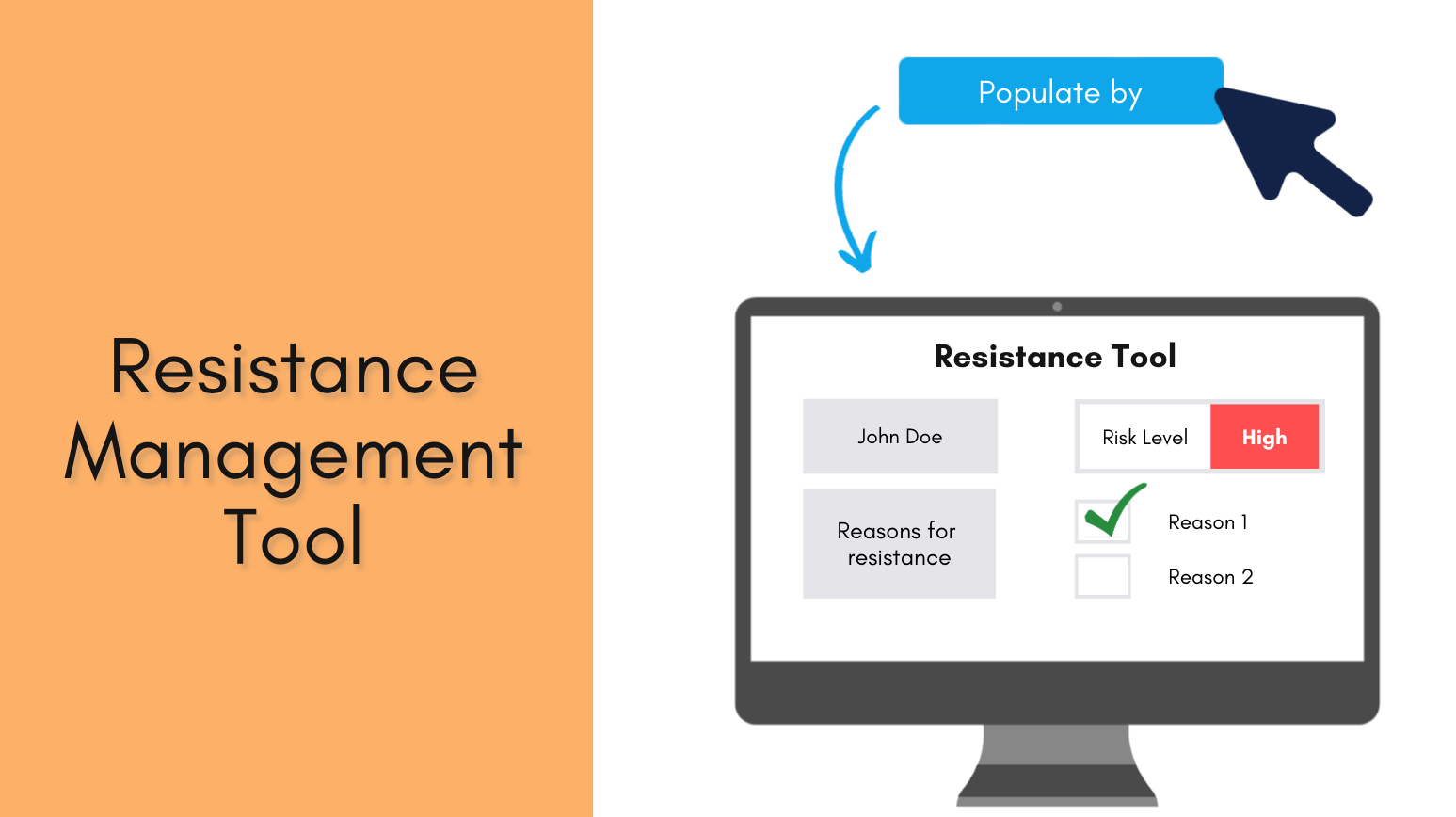
New Cloud Tool for Managing Resistance to Change in an Organization
In developing your reactive and proactive resistance management plans, you should consider identified behaviors. The more behaviors below you see from people, the more you are likely to deal with people resisting organization change within your group or company.

Is there a best resistance management plan that you have used that you would like to share with other project managers and change leads? Please, reach out and let us know.
Types of Workplace Resistance, that Signify Resistance to Change Management:
- Disengagement
- Putting up barriers
- Passive resistance
- Not following the new procedures (not performing the new way)
- Developing workarounds to the new solutions
- Agreeing to something in public/meetings, but not following through
- Not attending meetings, even when they are required
- Refusing to attend training sessions
- Not responding to emails or calls
- Continually “forgetting” meetings or other change-related tasks
The type of program, project, or change management resistance you confront will reflect each impacted groups’ culture.
For example, if you have a group that has an analytical culture, any resistance from that group will sound analytical in nature, and employees within that group are more likely to say something like: “I doubt this change will work. Show us the proof that it will work.”
For a group that is more community-driven, you will probably hear statements like, “Thank you for letting us know about the change. Now, what does everyone else think? Do you all believe this change can be successful?”
So, How Do You Overcome Resistance to Change?
Managing stakeholder resistance, including managers, employees, vendors, and customers’ resistance to a change will involve applying a two-prong mitigation process that we will cover in the sections below.
The first plan that will be reviewed below is the Proactive Plan, followed by a review of the Reactive Plan.
PROACTIVE RESISTANCE MANAGEMENT
Overview – Proactive Plan for Managing Resistance to Change
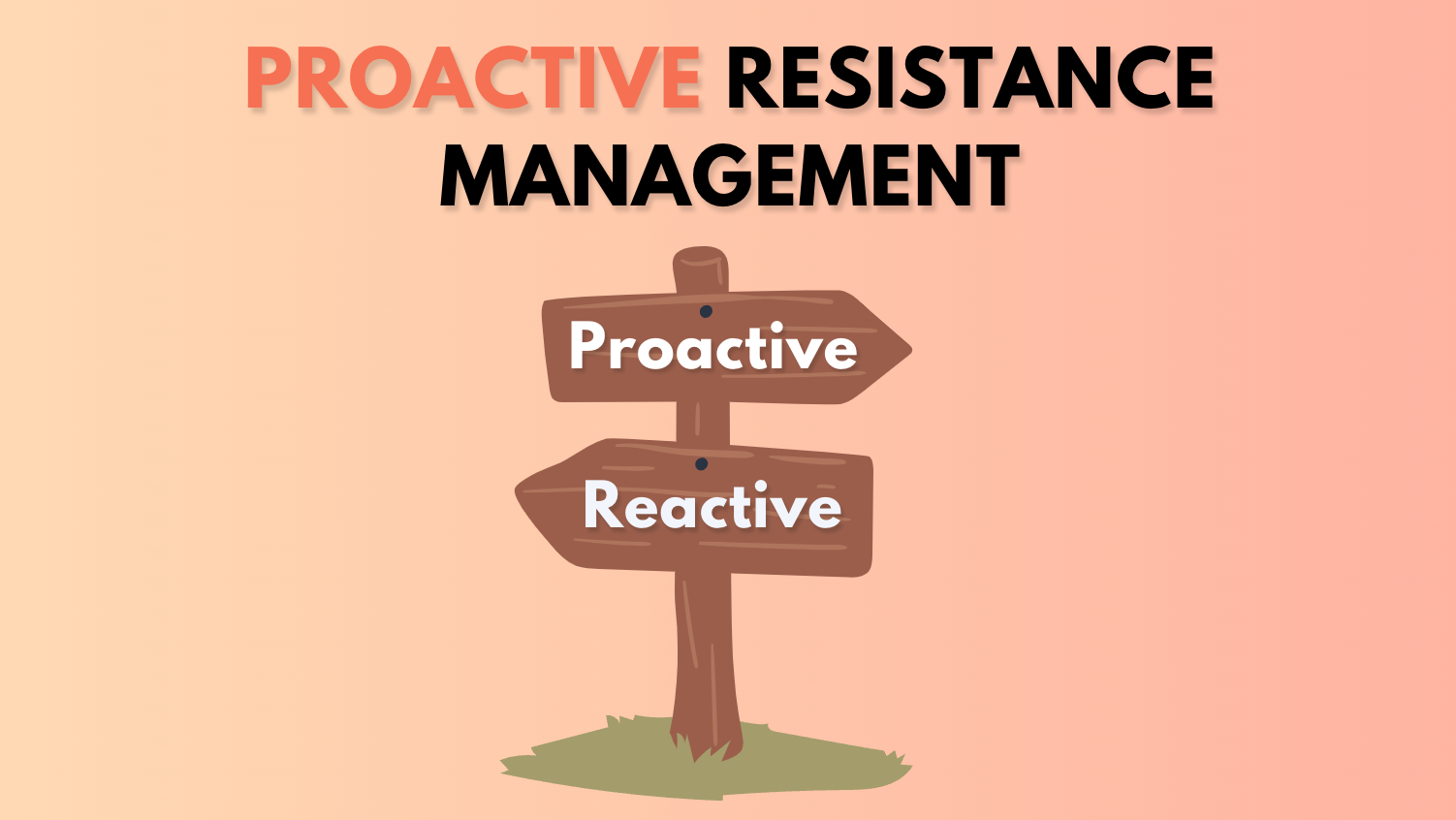
A proactive resistance management plan involves the assessment of potential points of resistance, as well as identifying existing levels of resistance, and then managing these resistance points upfront.
Unlike reactive resistance management, which involves reacting to unexpected/unanticipated resistances after they occur, a proactive strategy involves a preemptive approach on how to overcome resistance to business change.
A proactive strategy is similar to grabbing the bull by the horns, rather than cowering in the corner, and waiting helplessly for it to decide when and how to impale you.
In other words, with a proactive approach, you don’t wait for the unexpected/unanticipated resistance to happen and then react; instead, your goal is to identify where resistance might come from in the future and then proactively minimize the chances of people resisting organizational change in the future.
A proactive resistance management approach involves assessing each impacted group to understand their historical or existing receptiveness to change in general as well as understanding which individuals within these groups have been known to be resistant to the previous change.
It’s also important to gather data that can impact someone’s expected resistance or acceptance to a project. You’ll find some suggestions for the types of additional data points to collect in Step 2 below.
When developing your proactive resistance management plan, you should seek answers to key questions including:
- Are there known levels of resistance? Which groups are often known for resisting organizational change? Why?
- Where do we expect resistance to come from in the future? From which groups? Why?
- What will resistance look like if it does occur in the future? Why?
- How can we address and mitigate identified resistance before it has negative impacts on the project?
Proactive resistance management planning is the early identification of likely or existing resistance, so it can be addressed upfront.
Proactive Resistance Management Plan Implementation
Apply the 6-8 proactive strategies for overcoming resistance to change below to effectively identify and manage potential and existing points of resistance.
Click here to review a resistance management tool and get access to OCMS Portal’s free resources. This includes the “Overcoming Resistance to Change PPT” with the following steps:
1. Conduct Assessments to Identify Points of Resistance
2. Enter Identified Information into a Resistance Management Database
3. Determine Engagement Approach & Resistance Management Tasks
4. Determine Resistance Mitigation Owners
5. Enter Additional Information Into Resistance Management Database
6. Implement & Track Resistance Management Tasks and Activities
7. Conduct Ongoing Touch Points
8. Provide Ongoing Reporting and Status Updates to Program Leads
(Step 1) Conduct Assessments to Identify Points of Resistance
If you already have an existing list of potential points of resistance or a list of known resistors, that’s great.
In addition, you can follow the strategies below to identify more resistance points and individuals. Click here to review a resistance management tool, and also download “Overcoming Resistance to Change PDF” for managing resistance as part of the OCMS Portal free resources.
- Conduct a change impact assessment to identify the groups that will be heavily impacted. Assess each group’s bandwidth and capacity for the change. Low bandwidth and the high impact often lead to people resisting a change.
- Perform a comprehensive stakeholder assessment to identify key managers and leaders that will be impacted by the change, or who will be needed to support the program in order for the program to be successful. Assess these critical stakeholders’ receptiveness or resistance to the change.
- Conduct an organizational readiness analysis to assess how ready and prepared each impacted group/organization is for Go-Live. Groups that are completely unprepared and groups that need to undergo an extensive level of readiness will often resist the change.
- Meet with program managers, sponsors, key stakeholders, and supervisors that support the change to get their input on potential or existing points of resistance, as well as gather information on which groups are likely to resist organizational change.
- Set up a change champion network and conduct “resistance identification” sessions, and also learn how the change is being perceived within their organization.
- Meet with selected managers within impacted groups to assess their receptiveness to the change, as well as the overall receptiveness within their groups. Low levels of receptiveness indicate positive signs of resistance to the change.
- Send out surveys and questionnaires to gauge receptiveness or lack of receptiveness to the change.
- Meet with managers of groups with a history of resisting organizational change, and gauge their receptiveness to the change
Identified points of resistance, as well as information on stakeholders that are resisting the change, should be documented in a resistance management spreadsheet or Excel with actionable steps and mitigation activities. See below.
(Step 2) Enter Identified Information into a Resistance Management Database
Gathering the information listed above will be an ongoing process. As you progress with your information gathering, you can enter those details into a resistance management spreadsheet, software, tool, or platform.
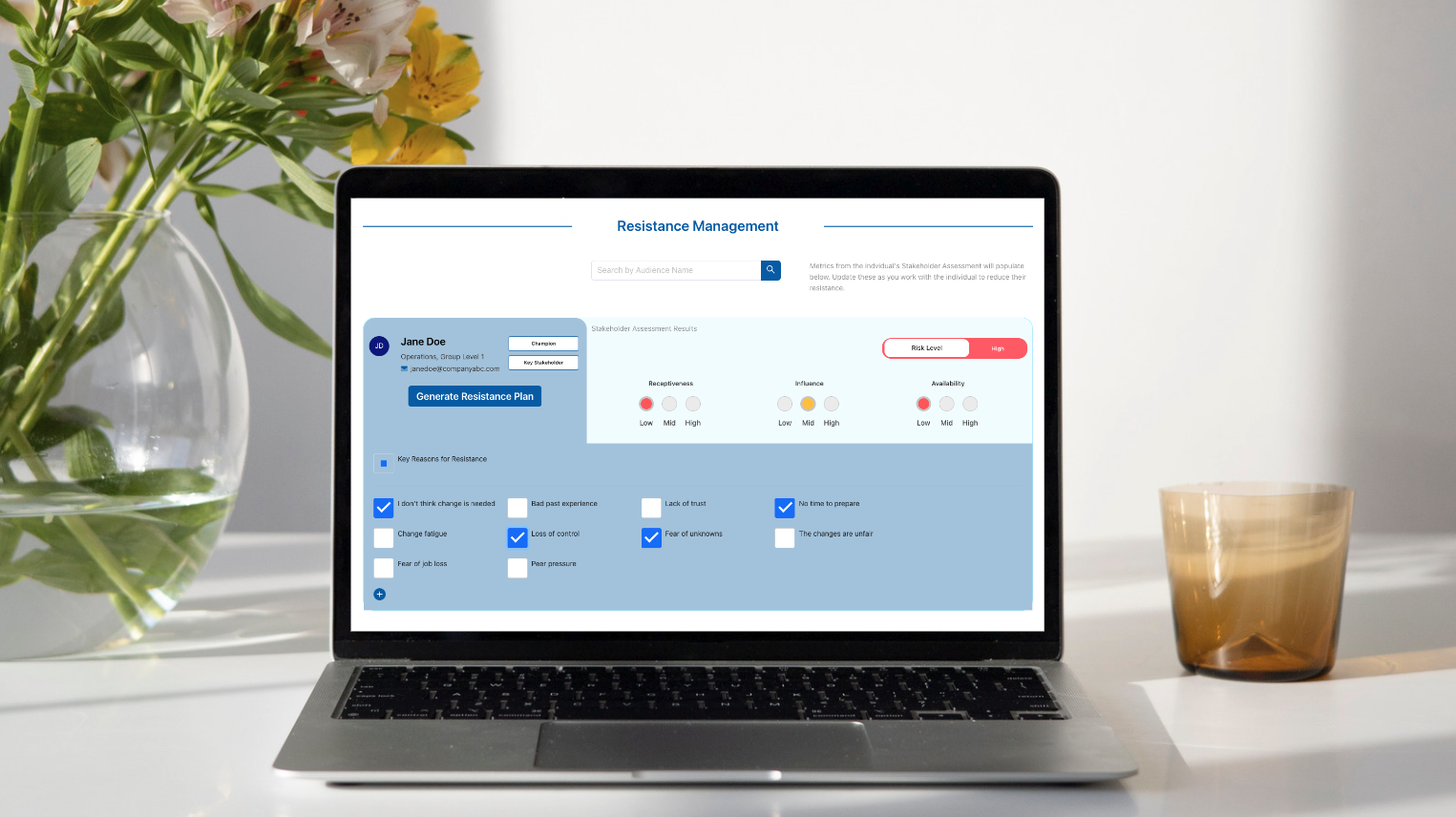
What type of information should you enter?
Using your resistance management template, you should document the following pieces of stakeholder information:
- Stakeholder types
- First and last names
- Job role/title
- Stakeholder organizational details (division, department, etc.)
- Ability to impact or influence the project
- Level of opposition to the change project
- Available bandwidth/availability
- Details on current stakeholder situation
- Planned tasks for engagement to mitigate resistance to change
- Details on how success will be measured
- Status on engagement success
- Notes for communicating progress to others
- Details for any tasks that have been assigned to the stakeholder
- The geographic location of stakeholders if you are tracking more than one office or geographical area.
Illustration –
OCMS Portal Resistance Management Tool – Resistance Assessment Attributes
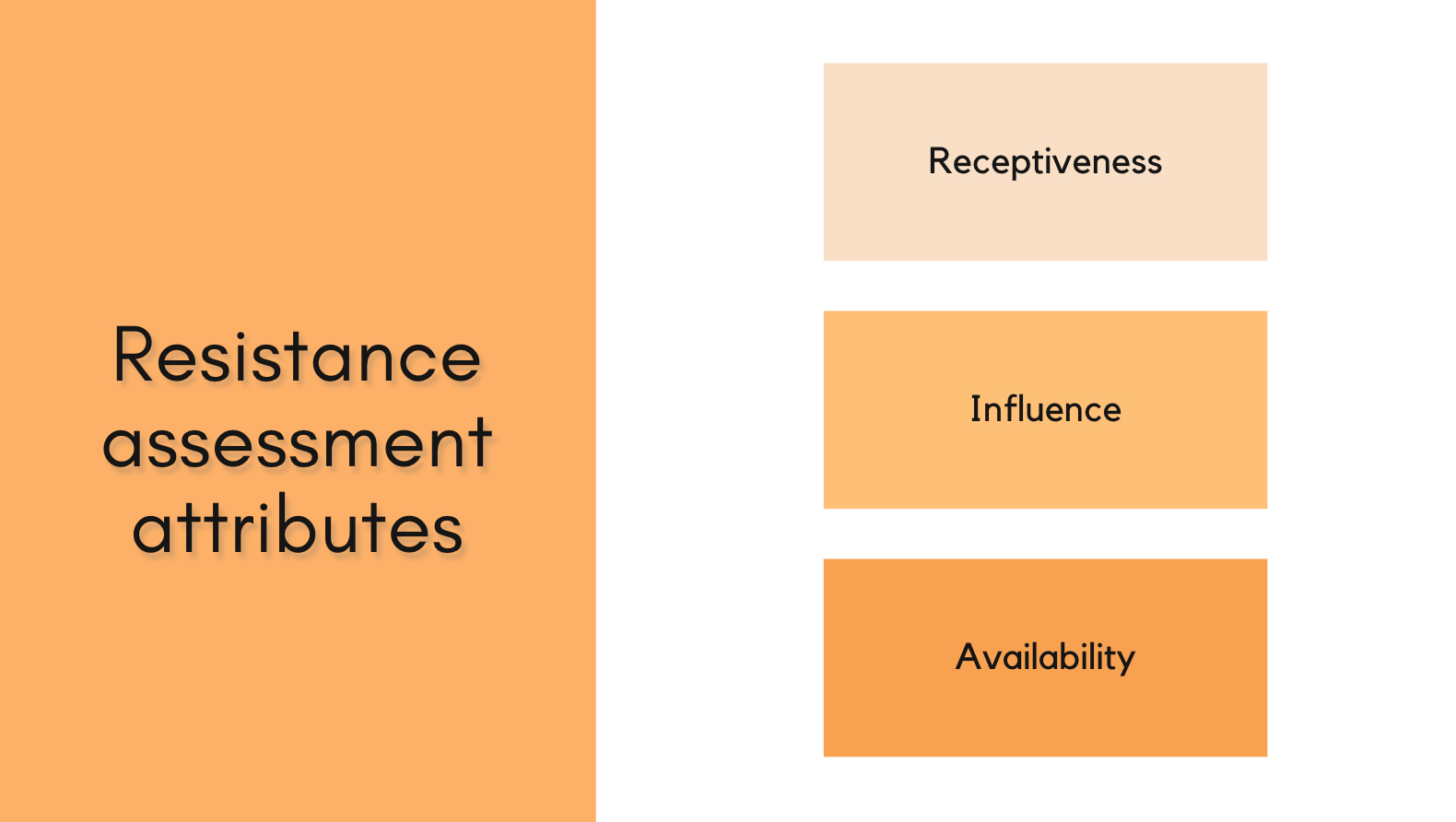
Now, let’s review a few of those key data points and why it’s important to gather these during your resistance management activities.
Stakeholder Types
You should separate your stakeholders by type, otherwise planning engagement is going to take you a lot more time, because whenever you look at your list of stakeholders, you’ll need to remember whether they’re a department head, executive, manager, vendor, etc.
If you use resistance management software that has a dropdown column for “stakeholder type,” you can easily classify your resisting stakeholders and sort and filter while planning and managing your resistance mitigation.
Ability to Impact the Project
Also, you will need to identify and map out each stakeholder’s ability to impact the project. This information will drive your engagement plan for each stakeholder and help you prioritize which are most critical.
For example, if a resisting stakeholder can significantly impact or derail a change, then you will need to implement a plan to gain that person’s buy-in or to at least bring them down from a high resisting level to a low resisting level.
Level of Opposition
Not everyone opposing a change will have the same level of resistance or be resisting the change project for the same reasons. Some stakeholders might be confused about how their position will change and so have just a slight amount of apprehension that can be cleared up with a Q&A to answer their questions.
Other stakeholders might have personal or deep-seated reasons for resisting the project and they may be at a high level of resistance. They may be so resistant that they are actively trying to stop the change from happening.
You’ll want to classify the level of resistance to change in the workplace for each stakeholder to help you prioritize your resistance management strategy.
This KPI can also be cross-referenced with the ability to impact a project to identify the most critical stakeholders to engage with. For example, those stakeholders that are highly opposed to the project and have a high ability to impact the project would be top on your priority list to engage with.
Illustration –
OCMS Portal Resistance Management Toolkit Interactive Report
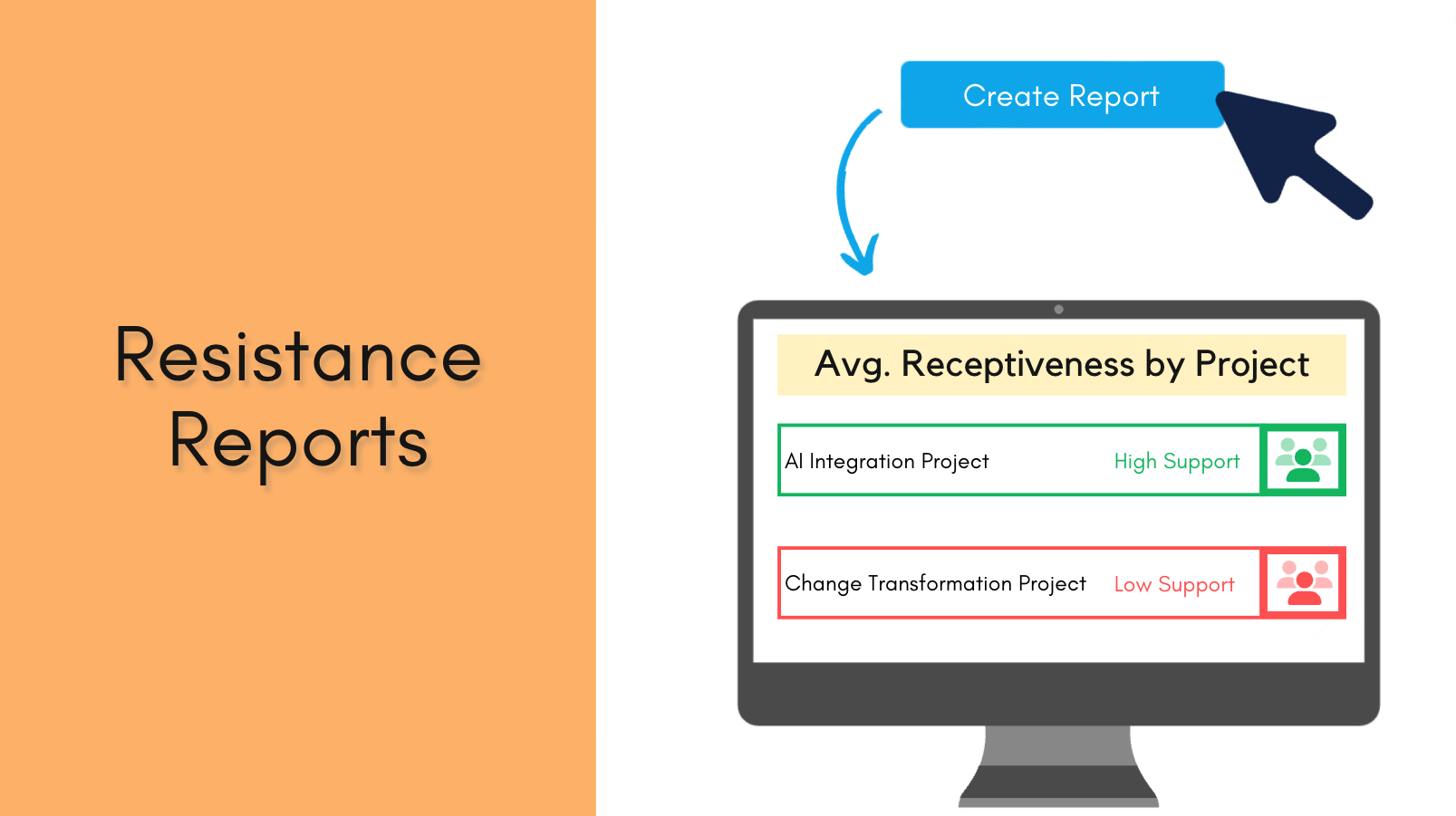
Available Bandwidth/Availability
One reason for resistance is if a person doesn’t have time to learn a new process, go to project-related meetings, or engage in other change activities. They may already be overwhelmed with their job duties and are resistant because they’re stressed and just trying to keep up with their daily workload.
Knowing a stakeholder’s available bandwidth can help you plan more effective resistance mitigation engagement. It can also help you pinpoint a potential reason for the lack of success when trying to engage with the person to reduce their level of resistance to the change project.
You can find tips on how to handle a lack of bandwidth by reviewing our Stakeholder Analysis Guide.
Details on Current Stakeholder Situation
During your resistance management, you’ll want to use a column on your resistance management Excel or template to summarize the stakeholder’s current situation.
You’ll include the answers to questions like:
- Why is the stakeholder resisting the project?
- What are the stakeholder’s concerns about the project?
- Is the stakeholder in a group or department that is resisting the change?
- What’s this stakeholder’s past experience with change projects? (Have they been resistant in the past?)
- Does this stakeholder have control over the project’s budget or timeline?
- What needs to be known about this stakeholder to help with resistance mitigation?
Leverage any details you may have gathered about the person during your Stakeholder Analysis, including the WIIFM (What’s In It For Me). WIIFM refers to what’s in it for the stakeholder. How is the change project going to benefit them?
WIIFM is a key discussion point during your resistance management engagement.
Illustration –
OCMS Portal Project Tasks Checklist for Planning Engagement Tasks
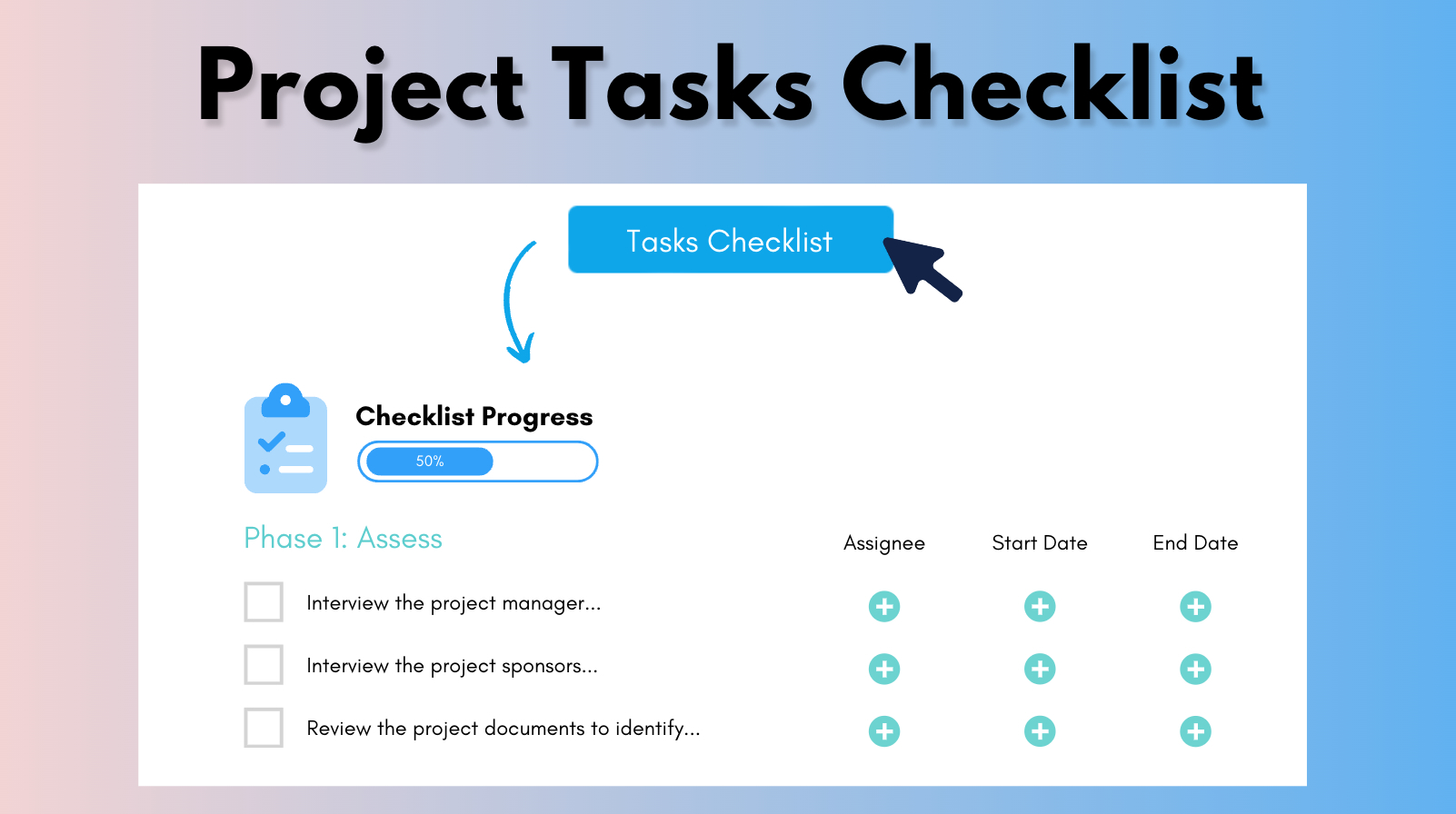
Click to learn more about the Stakeholder Analysis Toolkit
Details on How Success Will Be Measured
One of the other key pieces of information you need to decide as part of your strategy to overcoming organisational resistance is how you will measure successful engagement with the stakeholder. You don’t want the level of engagement success to be completely objective.
For example, if you are using “High,” “Mid,” and “Low” flags for tracking the engagement success level with a stakeholder, you need to define what each level means.
Try to use qualitative measurements along with quantitative information where possible. Qualitative would be a hard number measurement of something, like how many meetings were attended. Quantitative is descriptive and more subjective, such as how positive a person is feeling about a project.
The engagement success level is fluid and can change during your activities. In fact, your goal is to change it if it’s less than high. For example, you may initially have a low level of success getting the person to meet with you to discuss their concerns. But once you’ve had that opportunity, their engagement success may change to “high.”
You can use OCMS Portal’s Resistance Management Tool and Template for any kind of project. This tool is an online change manager that is designed to help you plan, manage, and execute a successful resistance mitigation strategy.
When implementing your strategies for overcoming resistance to change, you can choose from a Cloud or Excel version that includes real-time analytics and detailed resistance management metrics, as well as simplified templates for reviewing change project impact levels, resistance levels, and more.
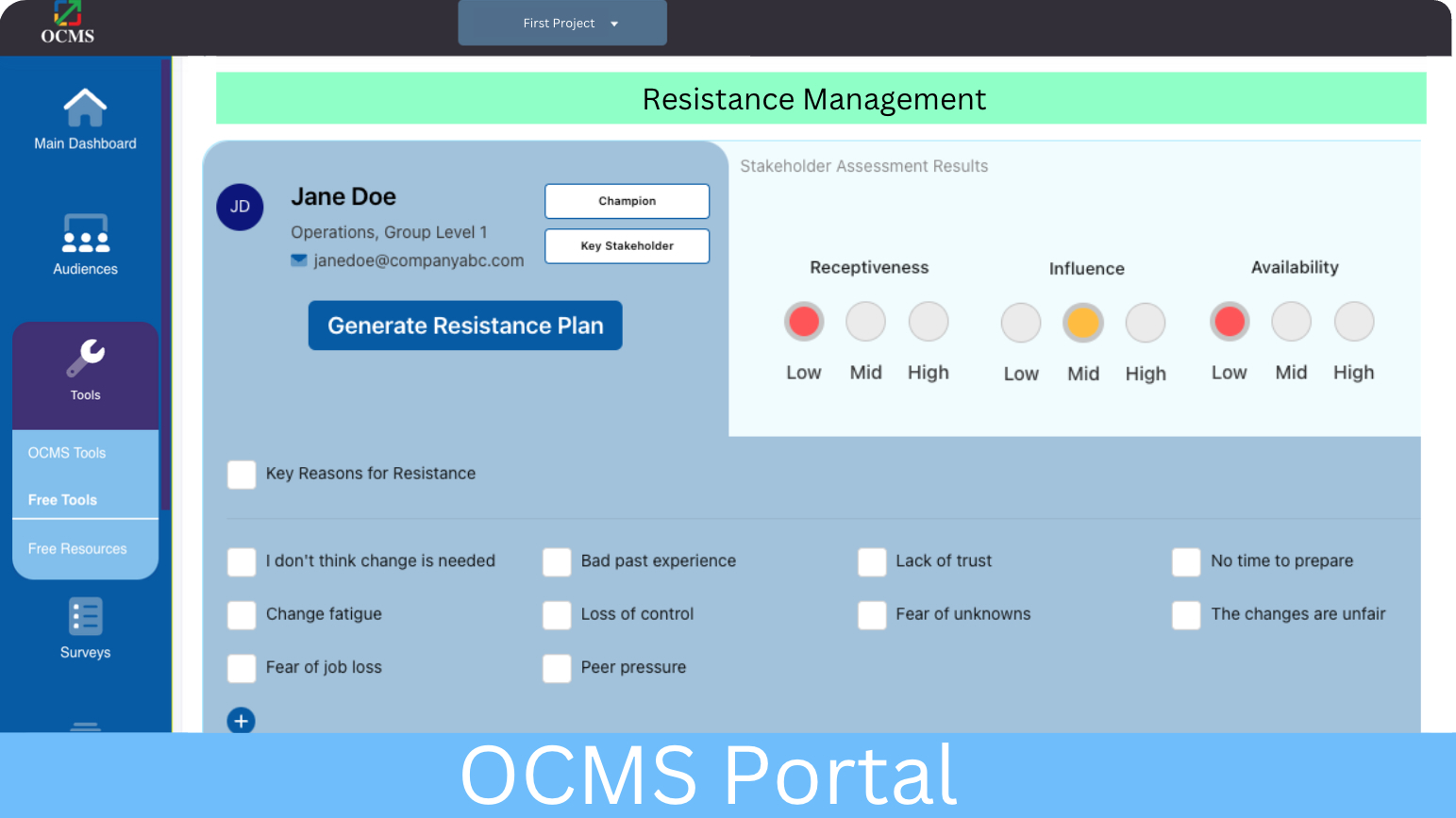
Template for entering and analyzing stakeholders for resistance or risk management
As part of your information gathering, make sure to work with the program team, project managers, primary sponsors, change champions, and key stakeholders, and also conduct stakeholder impact assessments to identify groups, as well as executives, business leaders, and managers within impacted organizations who fit the criteria below.
- Known to be resisting the change
- Has taken a strong opposing stance to the change program
- Has voiced little to no willingness to support the program
- Has resisted similar types of change in the past
- Is in a position to be able to strongly impact the success or failure of the change
Document your findings in the Database matrix included as part of this Resistance Prevention and Mitigation Tool.
(Step 3) Determine Engagement Approach & Resistance Management Tasks
The 3rd step in your strategies for overcoming resistance to change should involve determining and documenting the approach that will be used to engage each stakeholder who is resisting the change, as well as the resistance management tasks that are pending or in progress.
If you’re not documenting your resistance mitigation tasks, then things can quickly get away from you and slip between the cracks. You want to summarize the strategy for engaging with the stakeholder to reduce their opposition to the project as well as the tasks being taken to do that.
Be sure to have a way to show task progress status, due date, completion, etc., so you can easily see at a glance how your resistance management is progressing. Below is an example of how this is done in the OCMS Portal Opposition / Resistance Management Toolkit.
Illustration – Click below for additional information
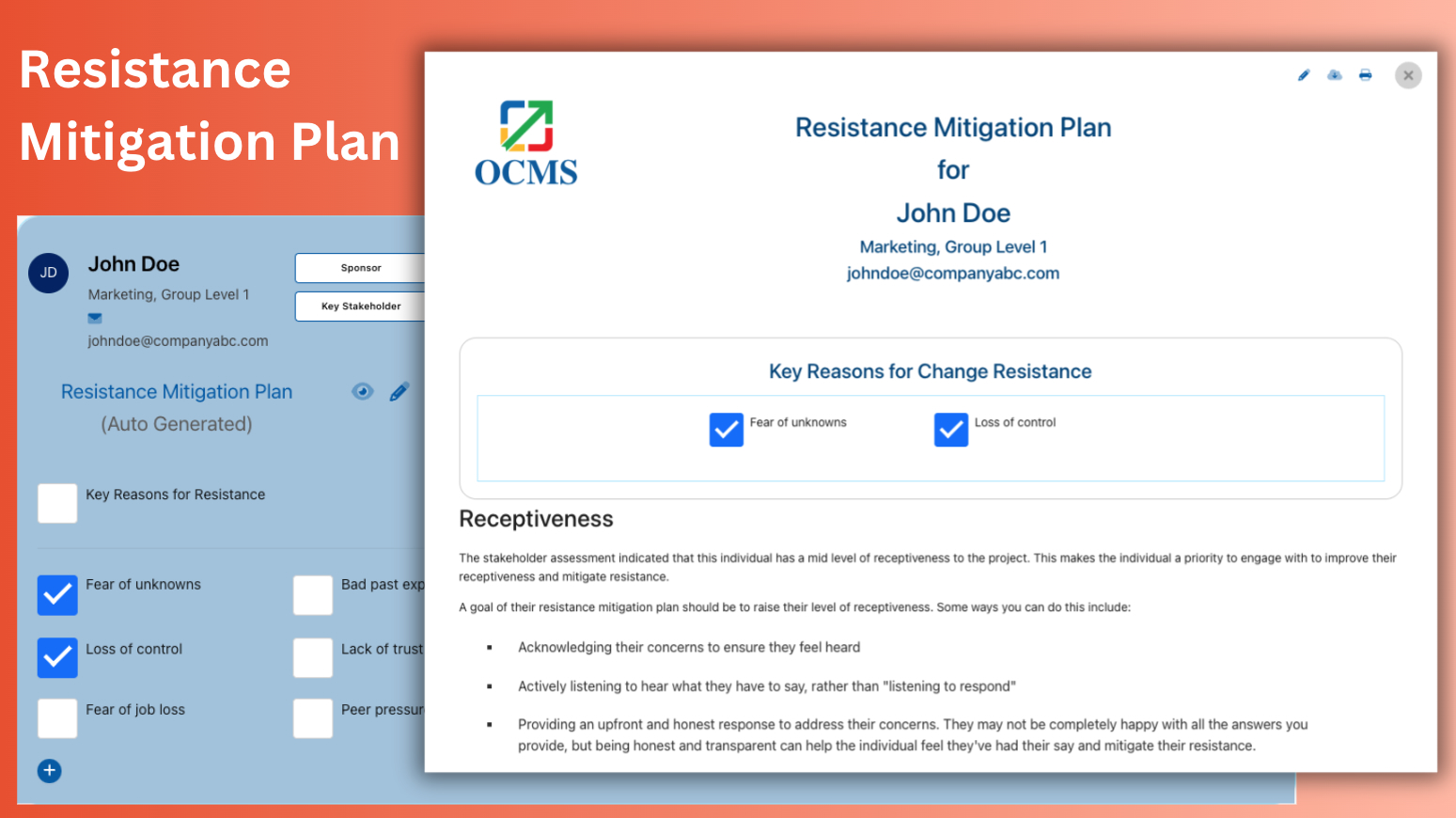
(Step 4) Determine Resistance Mitigation Owners
The next step in the process to overcome resistance to change in the workplace is to identify the person who will own the resistance mitigation for each stakeholder, and then enter that person’s name in a spreadsheet or change management tool along with the stakeholder they will be managing.
This identified individual (who will be referred to as the Resistance Mitigation Owner) will be responsible for meeting the stakeholder and working to reduce the customer, vendor, or employee’s resistance to the change.
A Resistance Mitigation Owner can be the Change Management Lead, the Project Manager, Program Manager, Project Sponsor, another key stakeholder, firm leaders, the stakeholder’s manager or superior, a Change Champion, or anyone that has influence over the resisting stakeholder.
Enter the identified Owner’s name in the “Assign Task to” column in OCMS Portal’s Resistance Management Tool or in a similar type of spreadsheet that you’ve created to task resistance management activities.
Illustration –
OCMS Portal End-to-end Task Tracking
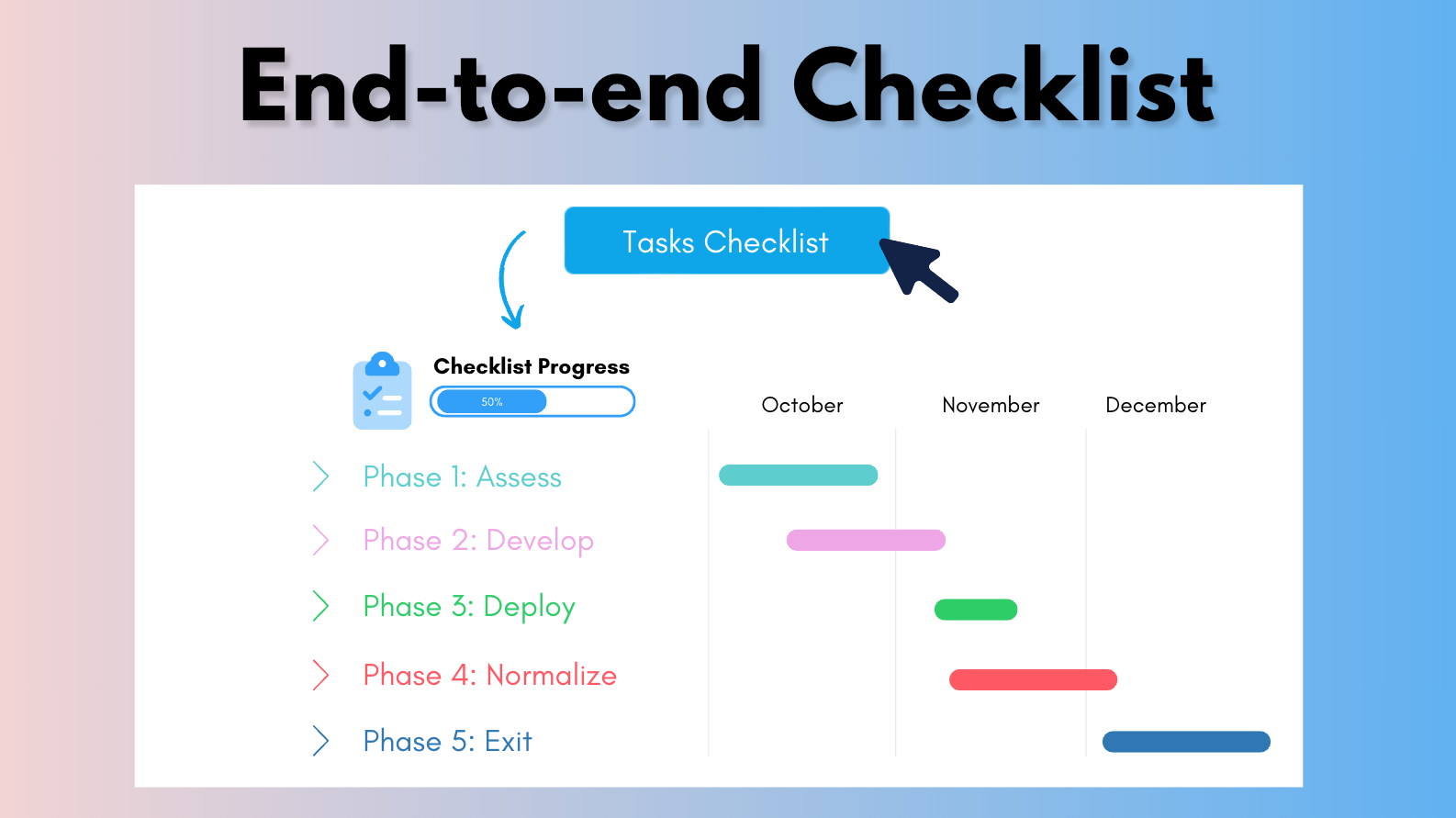
For more information on the best strategies to overcome resistance to change in your organization, please contact us.
(Step 5) Enter Additional Information Into Resistance Management Database
In addition to documenting the information noted above, you should also input any other key pieces of information you’ve gathered. This can include things like geographical details for your stakeholders if you are managing resistance to change across more than a single location.
This additional information will be used to plan out the next step of the resistance management process.
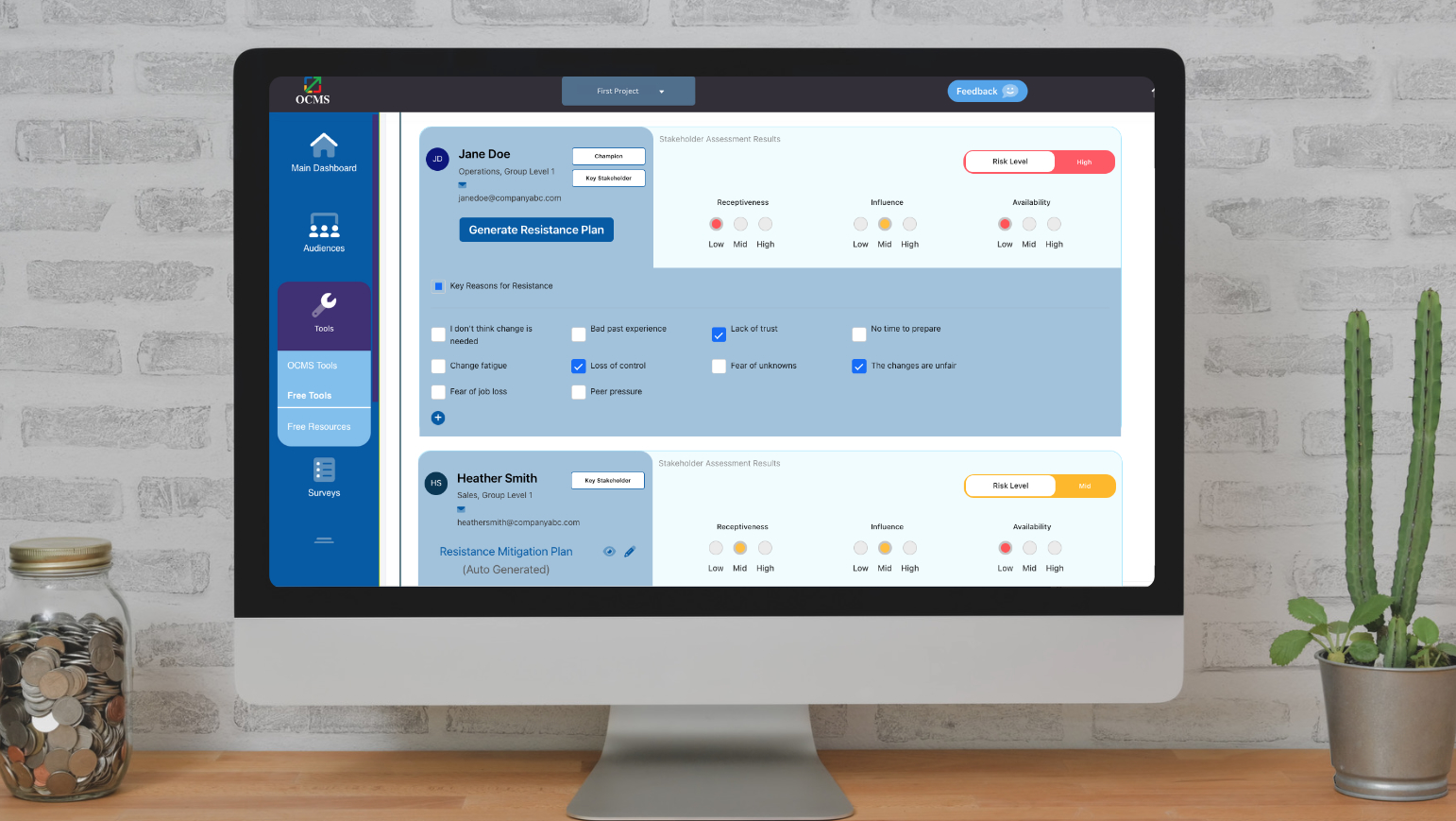
OCMS Portal’s Resistance Management Tool, a Simple Way to Manage Resistance to Change
(Step 6) Implement & Track Resistance Management Tasks and Activities
The next step will involve the “Resistance Mitigation Owner” scheduling one or more touchpoints to meet with their designated stakeholders.
A best practice is to meet 1-on-1 and in person. If that is not possible, then a video call or phone call can be used. Email is never a good way to engage and discuss issues that can be causing an individual to resist change.
The objectives of these touchpoints are to “meet and greet,” discuss the business factors driving the need for the change and assess/validate their willingness to support the change. Most importantly, discuss any issues or pain points the stakeholder might have about the change that needs to be resolved to get their buy-in and support of the change. Lastly, discuss the next steps and any tasks that you are assigning the stakeholder.
Some tasks for a stakeholder showing resistance to change may be:
- Review a video about the new process.
- Connect with the department’s Change Champion to get their input on how the change will be impacting & benefitting their group.
- Attend the next training session on the change project.
It helps to have an agenda when meeting with stakeholders for resistance management engagement. OCMS Portal’s Resistance Management Tool comes equipped with a Questionnaire to help drive meetings with these stakeholders.
Illustration –
OCMS Portal Resistance Management Tool – Built-in Questionnaire
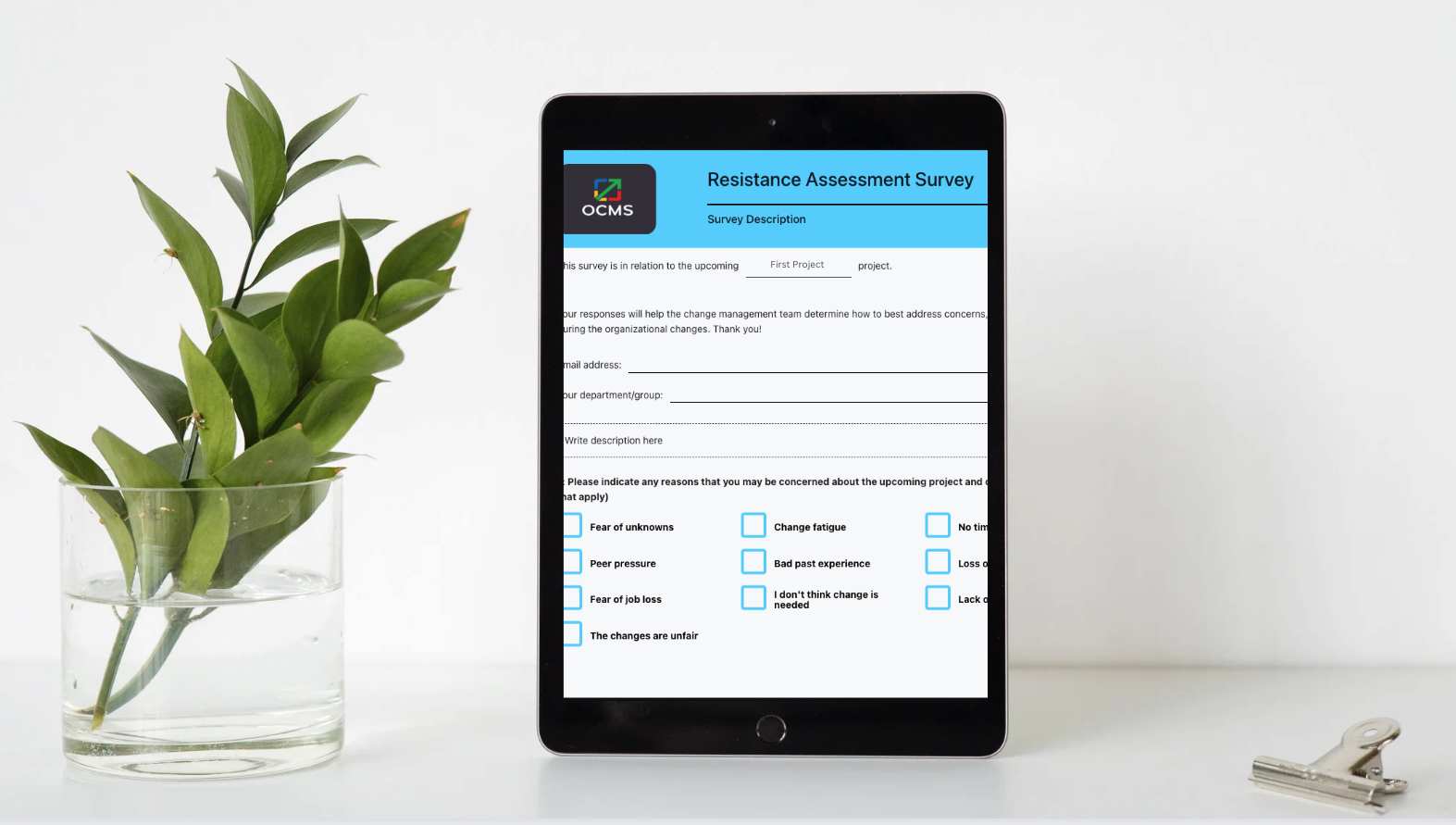
The list below presents key sources of resistance to change in the workplace that can help you understand what to expect.
- A lack of awareness (why is this change happening now? What are the benefits and risks of not changing? etc.)
- The WIIFM – what’s in it for me, is not clear to the person
- The individual does not believe that they have been given the right levels of training, skillset, and support that they need to be successful in transiting through the change
- Fear of job loss
- Shock and fear of the unknown
- Loss of control
- Lack of capacity and bandwidth
- Lack of reward
- Office policy conflict
- Loss of support system
- Previous negative experience to a change
- Climate of mistrust
- Empathy for others that are negatively impacted and peer pressure
- Fear of failure
As you and the team implement your activities for dealing with resistance to change, you should continuously document information in your stakeholder resistance and management template so you can effectively track progress. Tracking progress allows you to monitor each stakeholder’s journey: from a resisting level to a level where resistance has been completely mitigated or at least reduced from a high level to a lower level.
Document the following:
1. What needs to be done to remediate the factors causing this individual/group to have low receptiveness to the change?
2. Who else can be involved in the process to help remediate the issues and concerns?
3. What will be the next steps to mitigate the individual/group’s resistance level?
See Also: Cost of Resistance in the Workplace
(Step 7) Conduct Ongoing Touch Points
To ensure that you continue to overcome and address the sources of resistance to a change, there must be an ongoing dialogue with stakeholders.
For groups, individuals, and managers that are resisting the change the most, you and/or the Resistance Mitigation Owners should meet with them in person (if possible) regularly, to communicate the benefits of the change, as well as to emphasize what’s in for them.
Employees and managers with medium and low resistance levels should also be engaged, but just not as much as those with high levels of resistance.
Also, make sure to keep everyone informed on the progress being made to address their concerns, pain points, and issues with the change. This is a key technique for managing resistance to change in strategic management and planning.
- If a lack of awareness was an initial reason for a particular group’s resistance, then make sure to continue to provide them with the necessary levels of awareness, including the benefits of the change, and what’s in it for them.
- If a lack of skills or fear of failure was a resisting factor, then share your plans to provide training and coaching support to them/their group to help them adopt the change.

Irrespective of each individual’s level of resistance (low, mid, or high), you should ensure that each stakeholder is engaged throughout the implementation. You and the Relationship Owners should continue to work with these stakeholders to mitigate their concerns and fears of the program.
The engagement aspect of the proactive approach pays huge dividends in the long run as it allows you to build trust and rapport with impacted managers and stakeholders. And in return, you will be able to depend on these managers to help identify others who might be resisting the change or to help reduce resistance within their groups.
Don’t Miss: Types of Resistance to Change
Do you have more examples of the best ways for managing resistance to change in strategic management and planning? Email us and let us know.
(Step 8) Provide Ongoing Reporting and Status Updates to Program Leads
Use the OCMS Portal Resistance Management Tool’s interactive reporting dashboard to track your customer, employee, or manager resistance management success and progress, and also to report status updates to program leads, project sponsors, and other key leaders.
Alternatively, you can develop your own analytics tracking tool or resistance management Excel spreadsheet.
Some of the key information that you may want to chart includes:
- Percentage and number of stakeholders at high, low, and mid resistance levels
- The level of impact stakeholders have on a change vs their level of resistance
- Where opposition is coming from in your organization’s departments or locations
- Success/progress of your resistance management activities
Illustration –
OCMS Portal Resistance Management Software Analytics Reporting
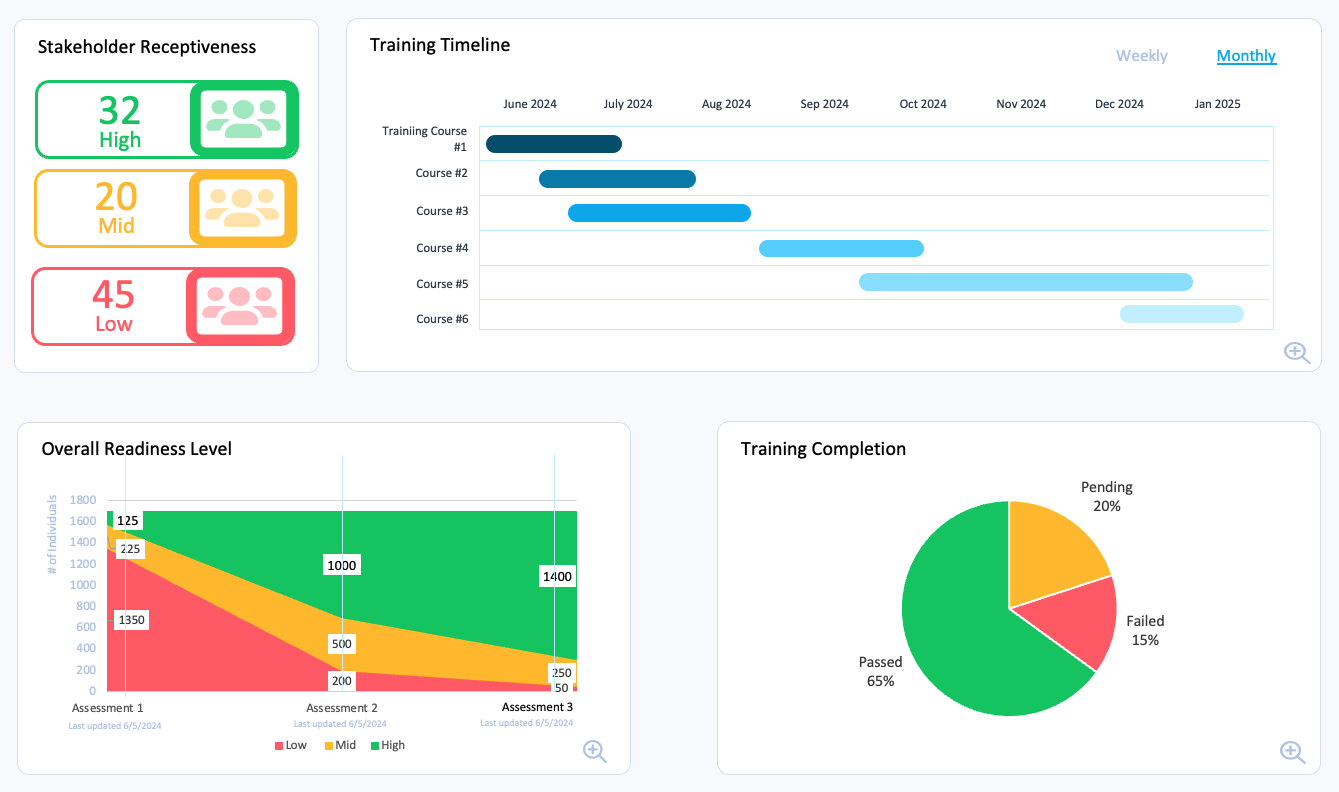
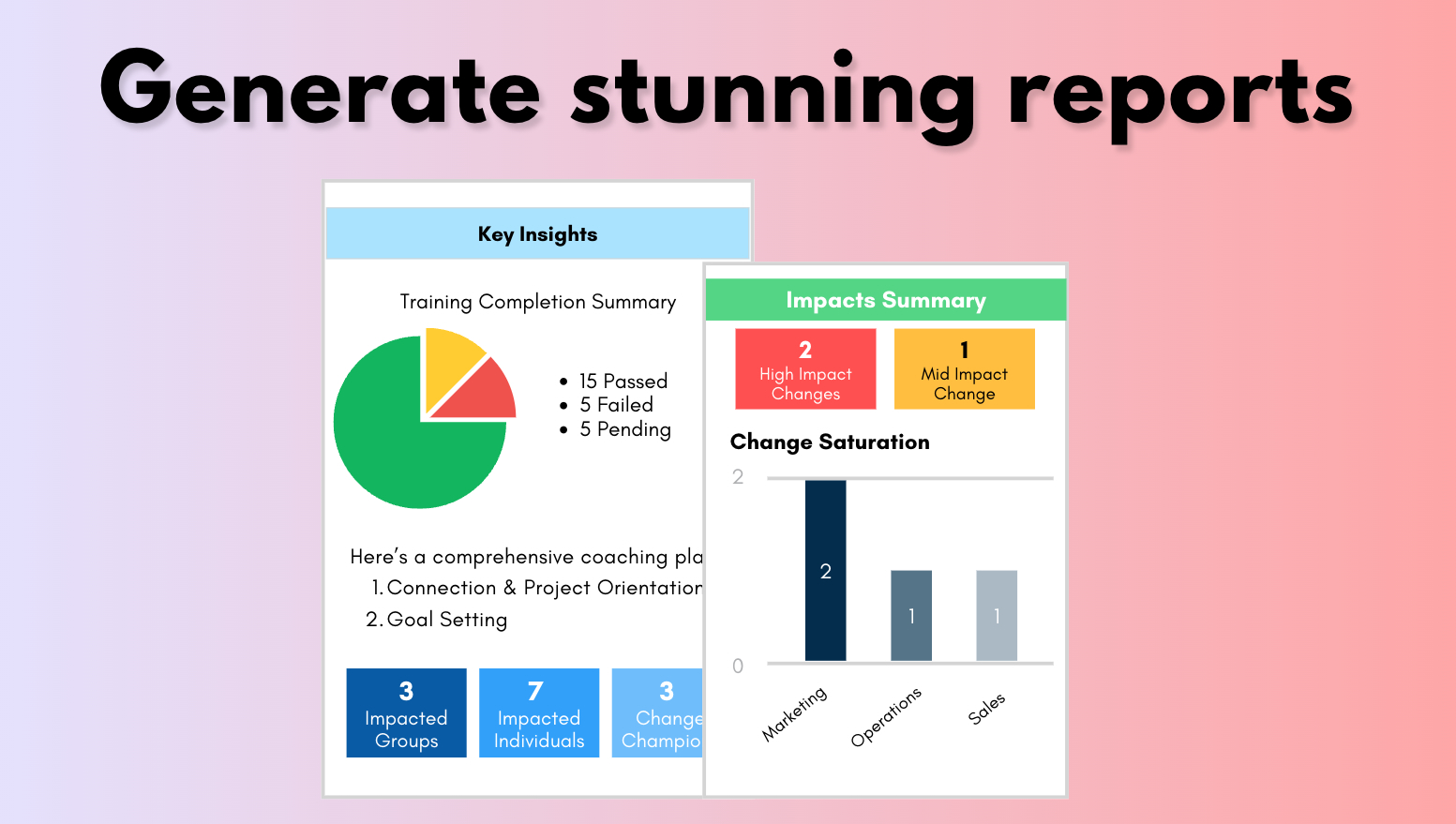
OCMS Portal Dashboard Analytics: Managing Resistance to Change
Let us know if you have any questions or comments about the Proactive Resistance Management Plan discussed above. The next section below provides a high-level overview of reactive resistance mitigation planning.
How Do You Measure Resistance, Availability, Etc.?
Surveys are an excellent way to capture the necessary KPIs for your resistance management analysis. You can survey stakeholders directly or those who manage the stakeholder.
One of the most effective ways to survey stakeholders who are resistant to change is through the built-in online survey tool. This makes it easy for users to fill out on any device, and the answers populate the tool directly. No need to collate several documents that have come in by email.
Illustration –
OCMS Portal Resistance Management Toolkit Includes Built-in Resistance Surveys to Capture KPIs
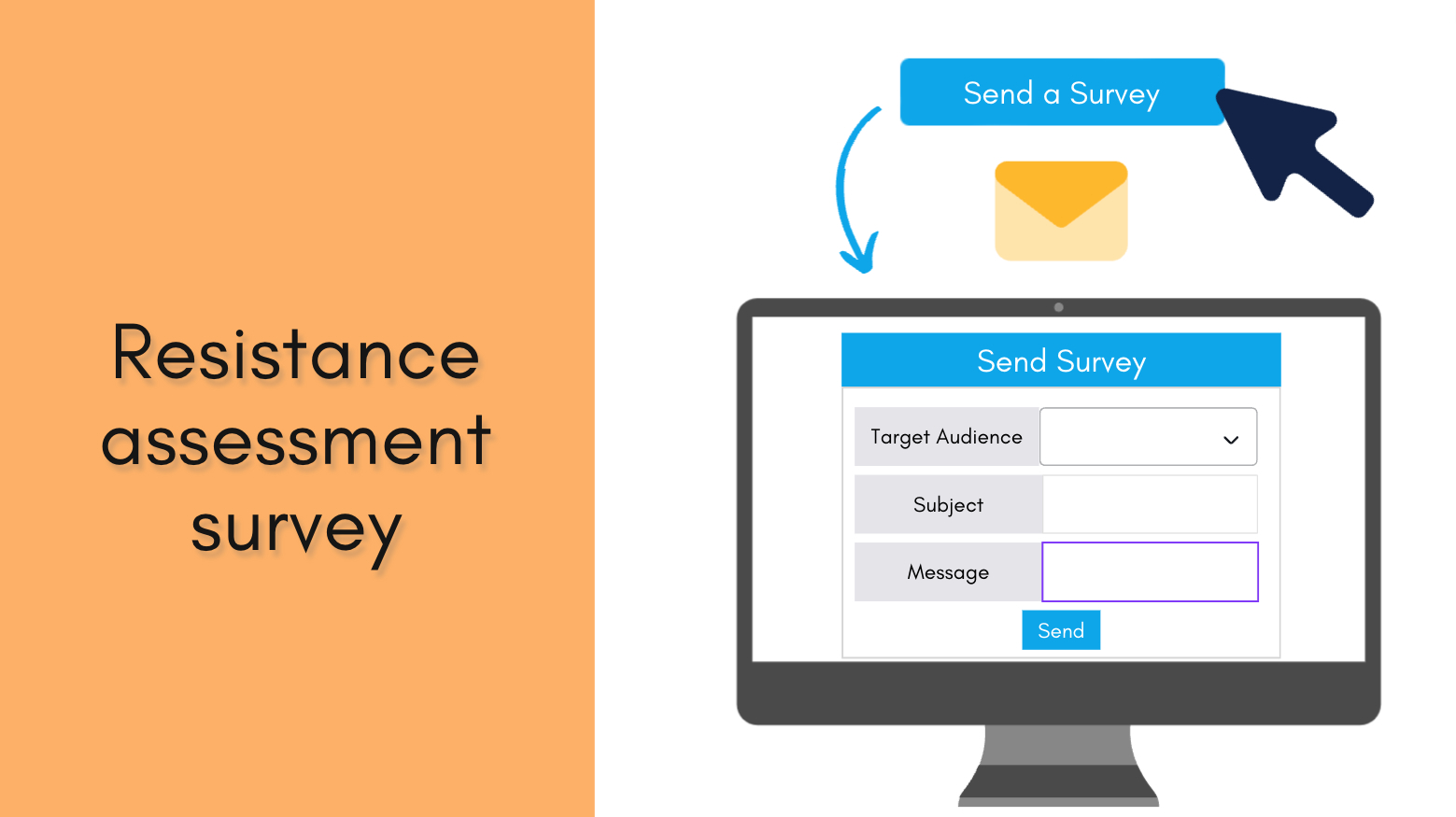
See Also: What is Resistance to Change?
REACTIVE RESISTANCE MANAGEMENT
Overcoming Resistance to Change Using a Reactive Strategy
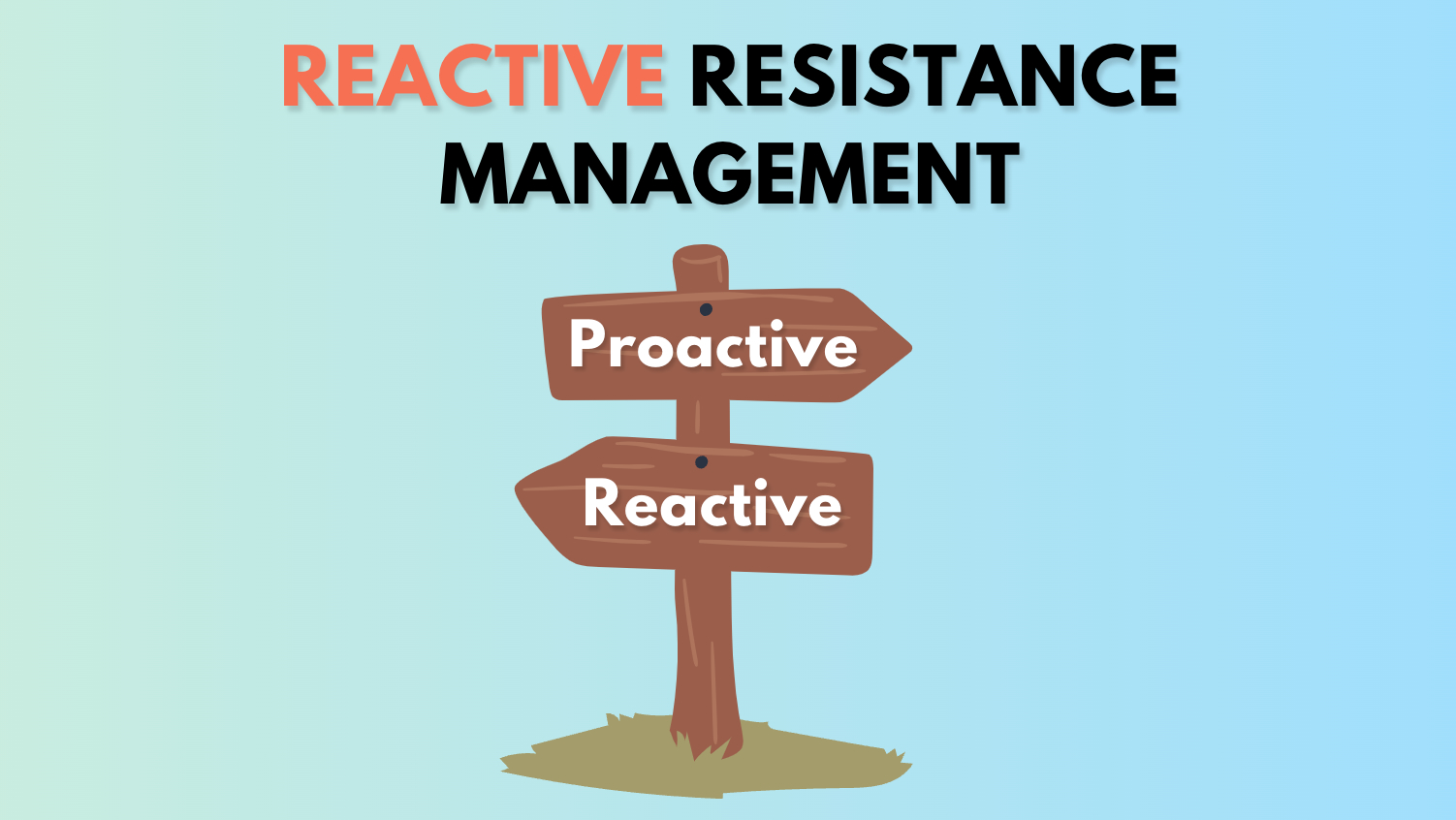
Reactive resistance management planning involves a reactive approach to overcoming resistance to change.
This is when you react after identifying resistance versus proactively working to mitigate resistance before it can occur (proactive resistance management planning is covered above).
Even with best efforts at proactive resistance management, there is still bound to be customer, vendor, manager, or employee resistance to change that you didn’t see coming. This is why you should also expect to employ reactive resistance management in addition to proactive.
For example, someone may not be resistant to a change until the change project begins interfering with their day-to-day work, at which time resistance to change crops up.
Resistance coming from people that the stakeholder works with or looks up to can also cause a person that wasn’t resistant at first to now oppose a project and cause the need to implement reactive resistance management.
View the list below to help you effectively identify when unexpected resistance has occurred. Leverage the steps listed in the Proactive Plan above to mitigate unanticipated resistance after it is identified.
How to Identify Resistance Throughout the Life of the Program:
- Conduct ongoing meetings with program managers, sponsors, key stakeholders, and supervisors that support the change. Get their input on any new resistance points, groups, or individuals.
- Set up a Change Champion Network and meet with these Champions regularly to assess how the change is being perceived within their areas of the organization and also to identify any resistance.
- Meet with mid and senior managers within impacted groups on an ongoing basis to assess their continual receptiveness to the change, as well as the overall receptiveness within their groups.
- Send out surveys and questionnaires.
- Also, you can directly observe resistance. See the list below.
Direct Observation of Stakeholder Resistance:
- Disengagement
- Putting up barriers
- Passive resistance
- Not following the new procedures and not performing the new way
- Developing workarounds to the new solutions
- Agreeing to something in public/meetings, but not following through
- Not attending meetings, even when they are designated as required attendees
- Refusing to attend training sessions
- Not responding to emails or calls
- Continually “forgetting” meetings or other change-related tasks
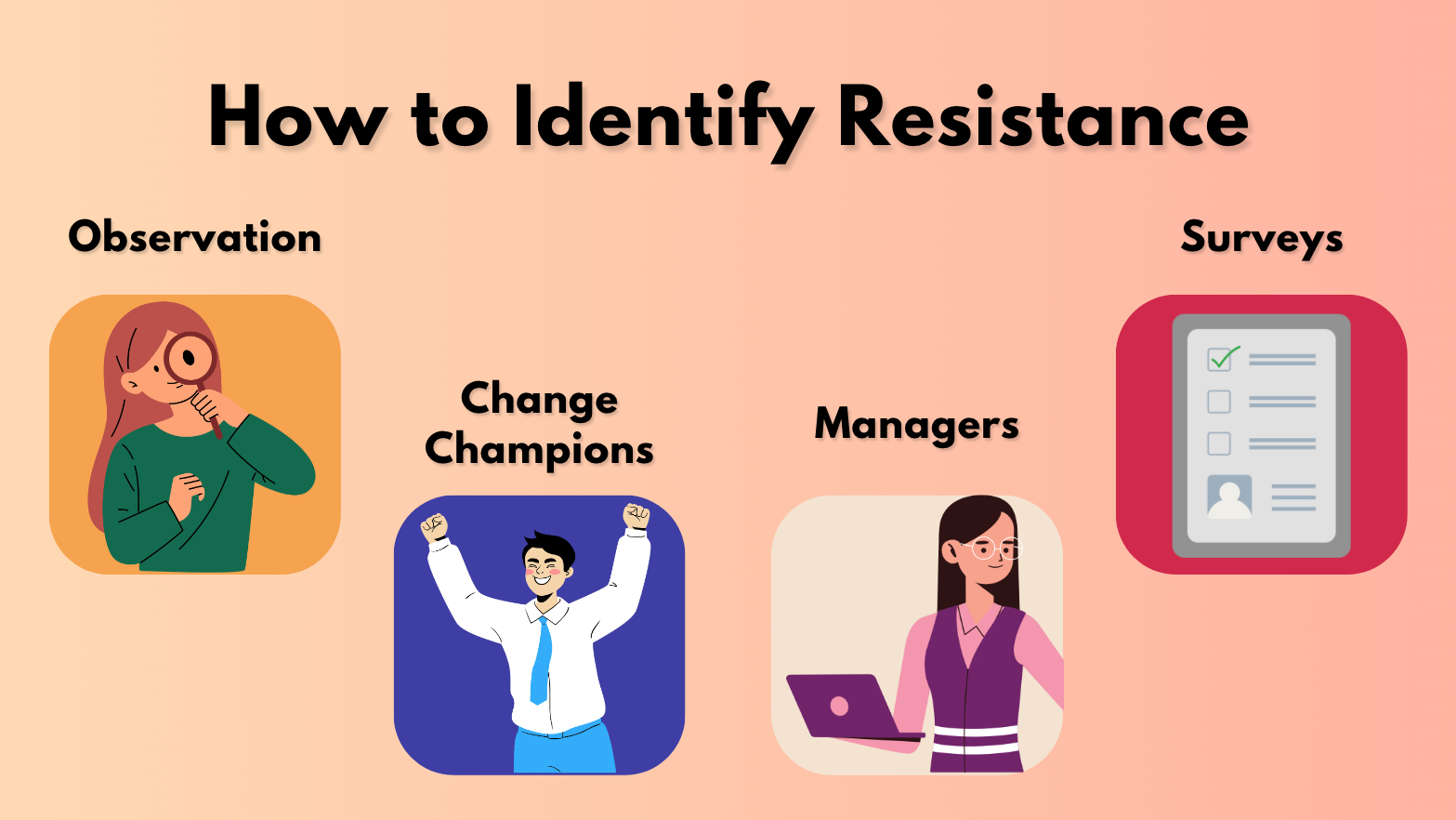
Identified resistance and resistors (individuals or groups) should be documented in a Resistance Management Matrix with actionable steps and mitigation activities. Leverage the information outlined on this page to develop your matrix. In addition, you can review this page that covers OCMS Solution’s Resistance Management Tool & Matrix.
Additional Techniques for Addressing Different Types of Resistance to Change in the Workplace or with Customers
AIM published an article on “How to Manage Resistance to Change” and here is a list of techniques from that article that you can use for addressing and overcoming resistance to change, in addition to what is presented in this Guide.
- “De-Personalize” the resistance: Do not take resistance to the change personally. It is not about YOU.
- Start looking for resistance to the change as soon as possible. Don’t wait until it is so severe that it becomes extremely difficult to mitigate it.
- Communicate frequently and allow end-users to express their thoughts and feelings about the change.
- Involve employees in the implementation process. Make them feel like partners, versus people that something is being done to.
- Don’t punish employees for expressing their resistance. Always strive to bring covert resistance out in the open. When resistance is covert, it makes it very difficult to identify and mitigate.
- Managing resistance is not “a one time, check the box, then you are done” event. As the implementation evolves, so will resistance. As such make sure that you are using reactive and proactive resistance management techniques to assess, identify, and resolve levels of resistance throughout the change implementation.
In most cases, the resistance is best managed by the direct supervisor or highest-level manager in the chain of command for the employee, group, or employees that are resisting the change. As such, you will need to work with managers, project sponsors, SMEs, Change Champions, and key stakeholders to implement the resistance management plans.

1:1 meetings are one of the best practices for managing resistance to change in the workplace.
The True Costs of Resistance to Project or Business Change
It is extremely important to develop and implement plans that address the reasons for resistance to change. If not resolved quickly and early on, organizational resistance to a change, project, program, or initiative often comes at a huge cost to the organization.
Such costs include:
- Recurring project delays, missed deadlines, and being behind schedule
- Desired outcomes, return on investment (ROI) and project objectives are not achieved
- Project is forced to be abandoned
- Productivity declines
- Absenteeism
- Valuable and high performing employees decide to move on to other firms
- Extra risk, extra costs, and inefficiencies
OCMS Portal: Resistance Management Tool
The OCMS Portal All-in-One software which provides a full suite of solutions for how to manage resistance to change includes a best-in-class resistance management database template, samples, a 360-degree interactive analytics view of stakeholders by resistance level, and much more that you can leverage to simplify and optimize your change resistance mitigation activities.
OCMS Portal is a full-featured cloud platform to help you plan, manage, and execute a successful change project, end-to-end, whether this is your first change project or your one-hundredth. You can choose several toolkits on the platform or just choose the Resistance Management Planning & Management Toolkit.
Do you have any questions about “How to overcome resistance to change”? or about resistance change management in general. Please reach out and let us know.
Getting Started with Your OCM Solution Resistance Management Tool
If you subscribe to OCMS Portal change management platform, you’ll immediately gain access to the resistance management template and matrix mapping tool, here’s how you get started!
Once you’ve subscribed, you’ll be automatically signed in and be taken to the Main Dashboard page of OCMS Portal. You can find your resistance management tool in the Phase 1: Asses of the OCM framework.
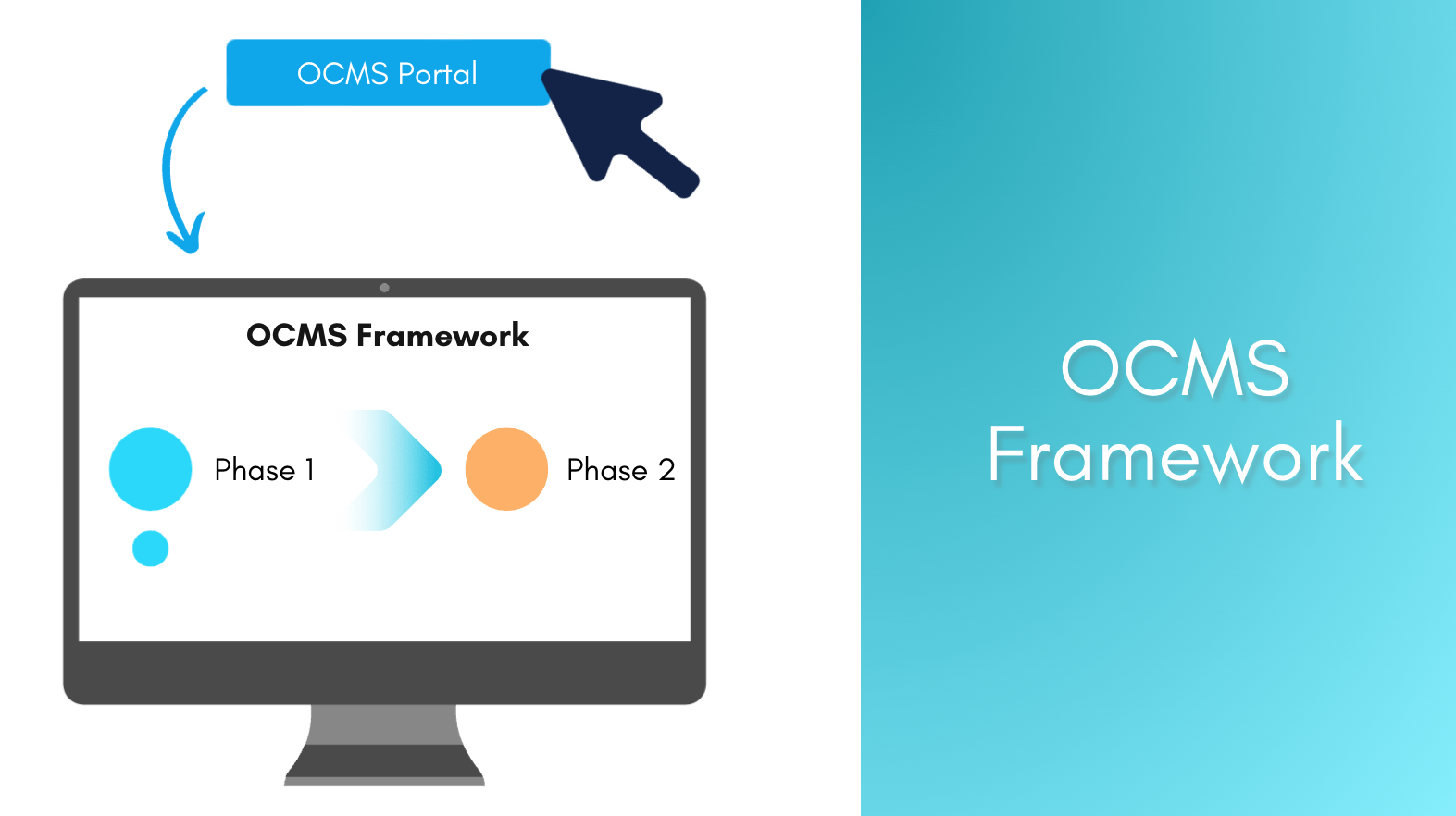
Note that our software includes loads of free change management resources such as Reasons for Resistance – Strategies to Overcome, OCMS Overcoming Resistance to Change, as well as a Resistance Management Checklist, and much more.
Click below to purchase this tool and for instant access that will allow you to get started right away.
Resistance to change is when impacted audiences and individuals are not supportive of a change which results in them acting in ways that negatively impact the success of the change.
People generally do not like change. It is normal human behavior to develop habits that become ingrained and difficult to change. Key reasons why people resist change include having to learn the new way of doing things, fearful of a negative impact to them, and currently being burdened with too much change
A resistance management plan involves the set of steps, strategies, activities, and approach that will be used to identify, evaluate, document, manage and resolve resistance to a change.What is Resistance to Change?
Why Do People Resist Change?
What is a Resistance Management Plan?
Note: Content on OCM Solution's ocmsolution.com website is protected by copyright. Should you have any questions or comments regarding this OCM Solution page, please reach out to Ogbe Airiodion (Change Management Lead) or the OCM Solutions Team today. OCM Solution was previously known as Airiodion Global Services (AGS).
External Sources: Microsoft 365 Clip Art Image(s) (Bing images licensed under the Creative Commons license system.), stock.adobe.com, https://pixabay.com/photos/robbinhiggins-annoyed-disgusted-2763643/, https://www.imaworldwide.com/blog/how-to-manage-resistance-to-change, https://www.ls.graphics/free/free-pixel-4-and-pixelbook-go-mockup, https://pixabay.com/photos/application-request-ipad-tablet-1883453/



